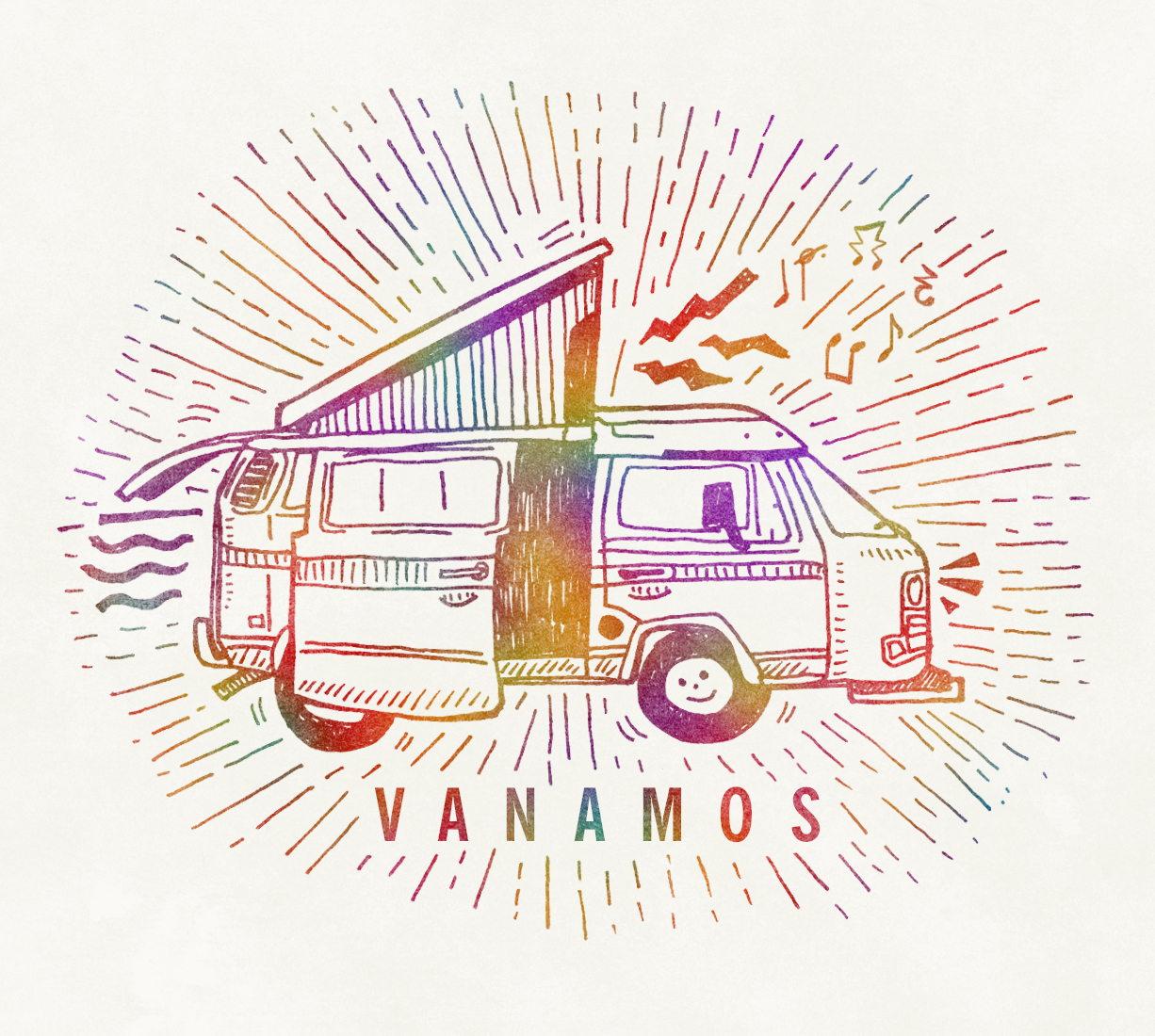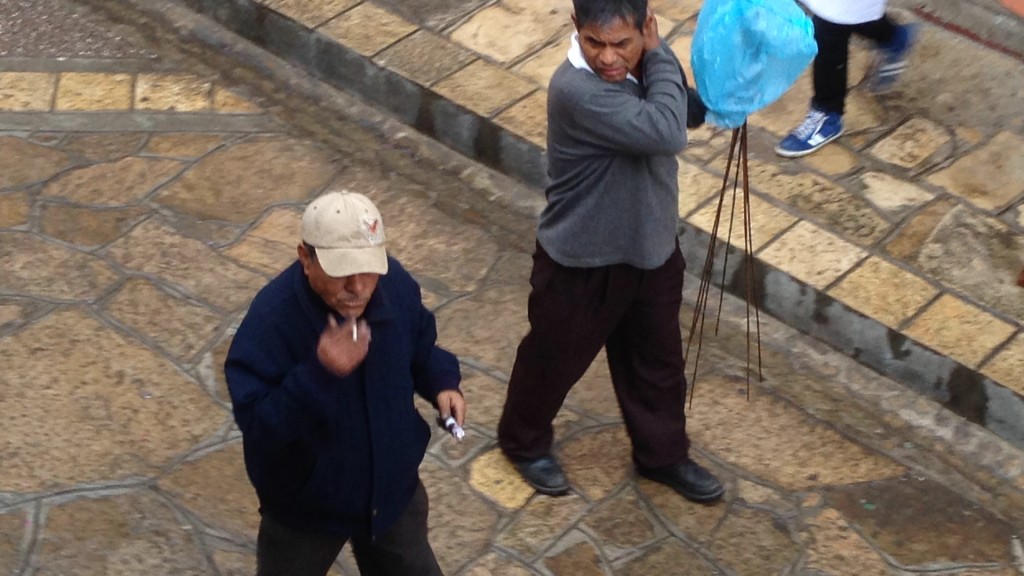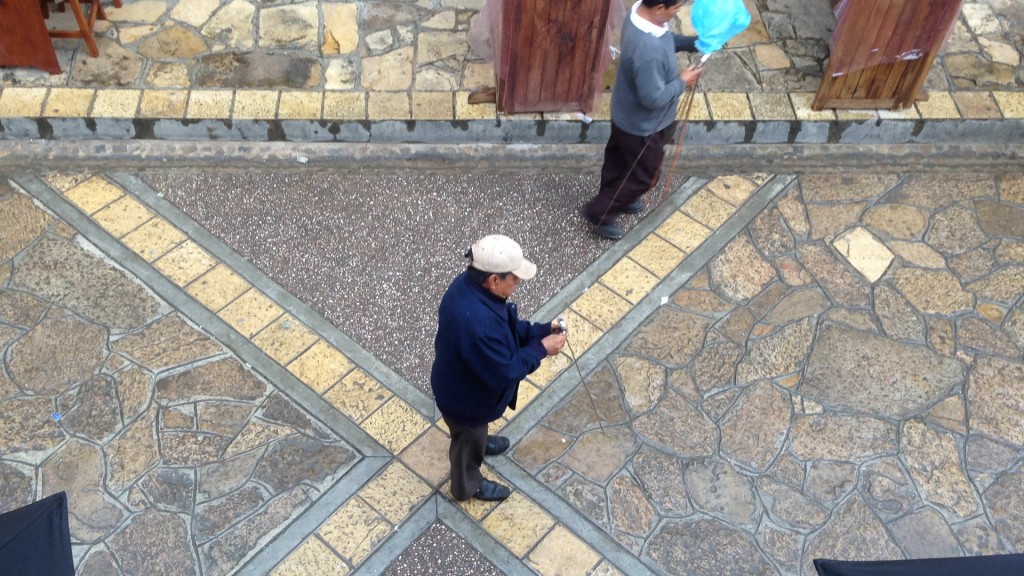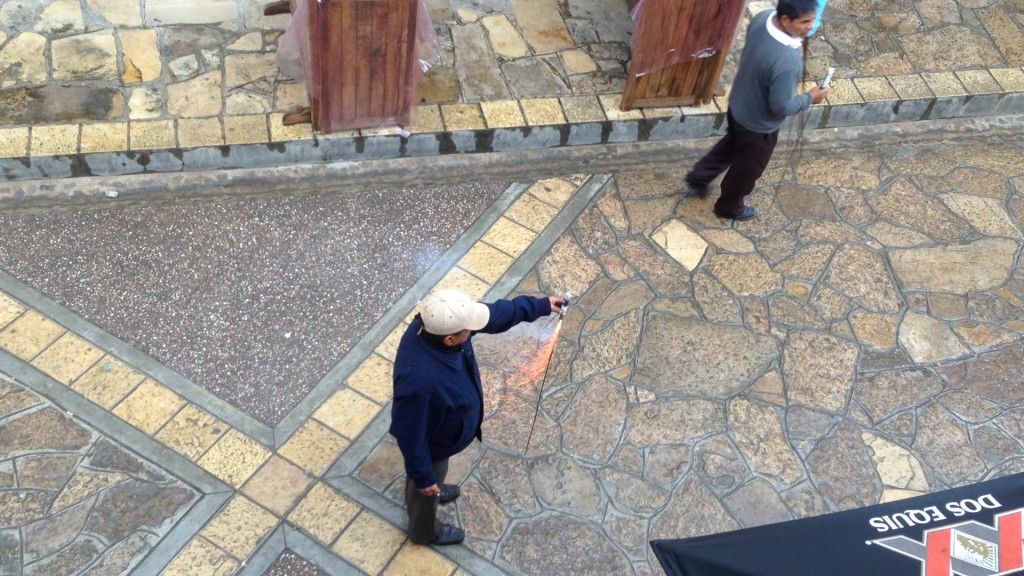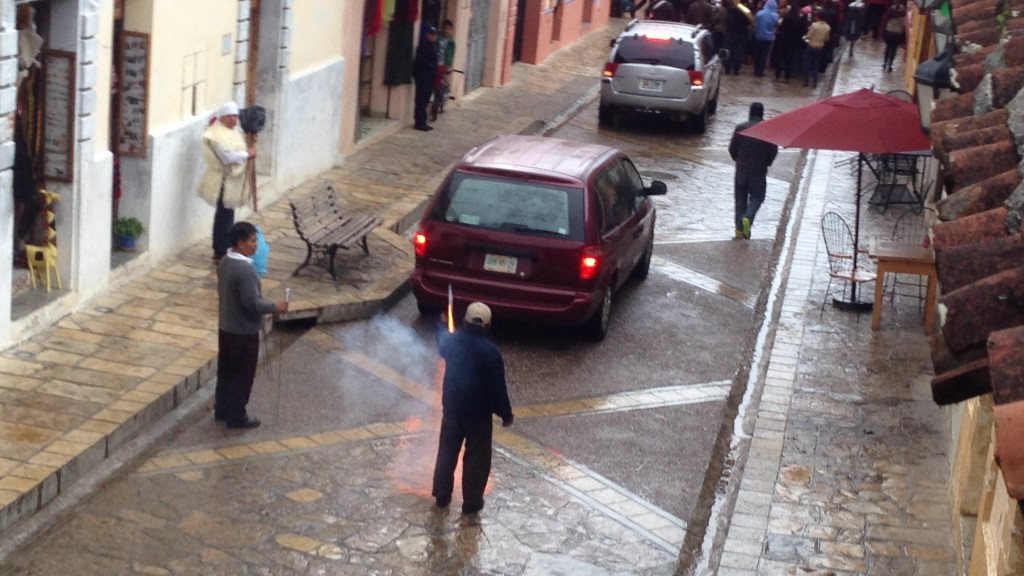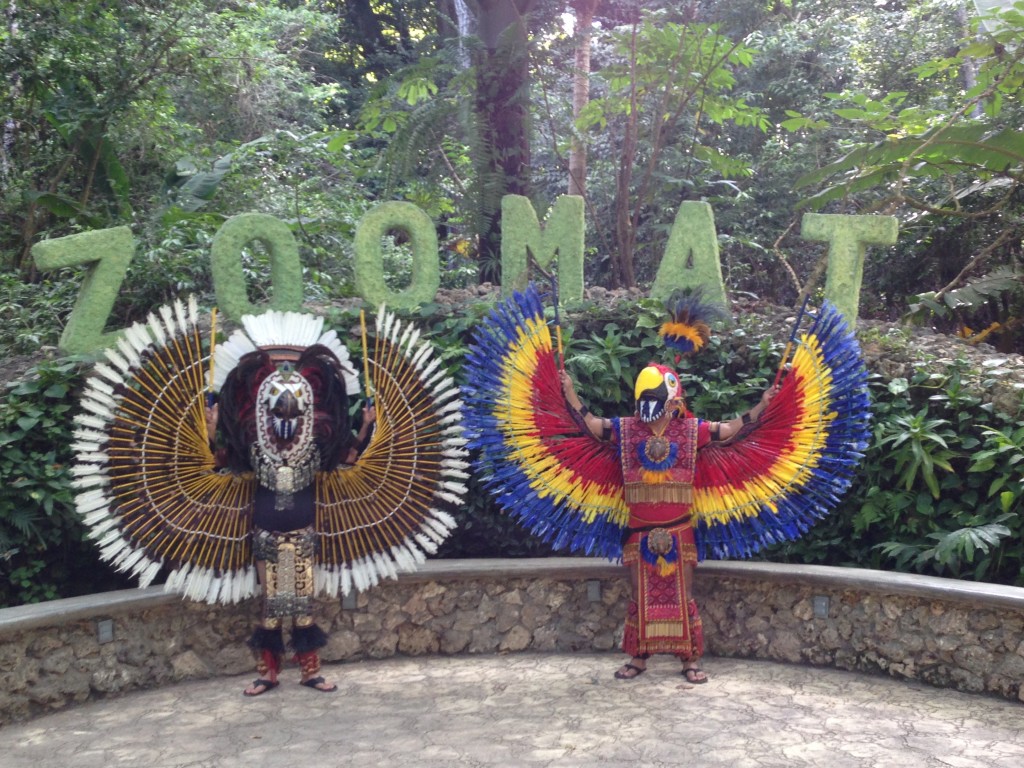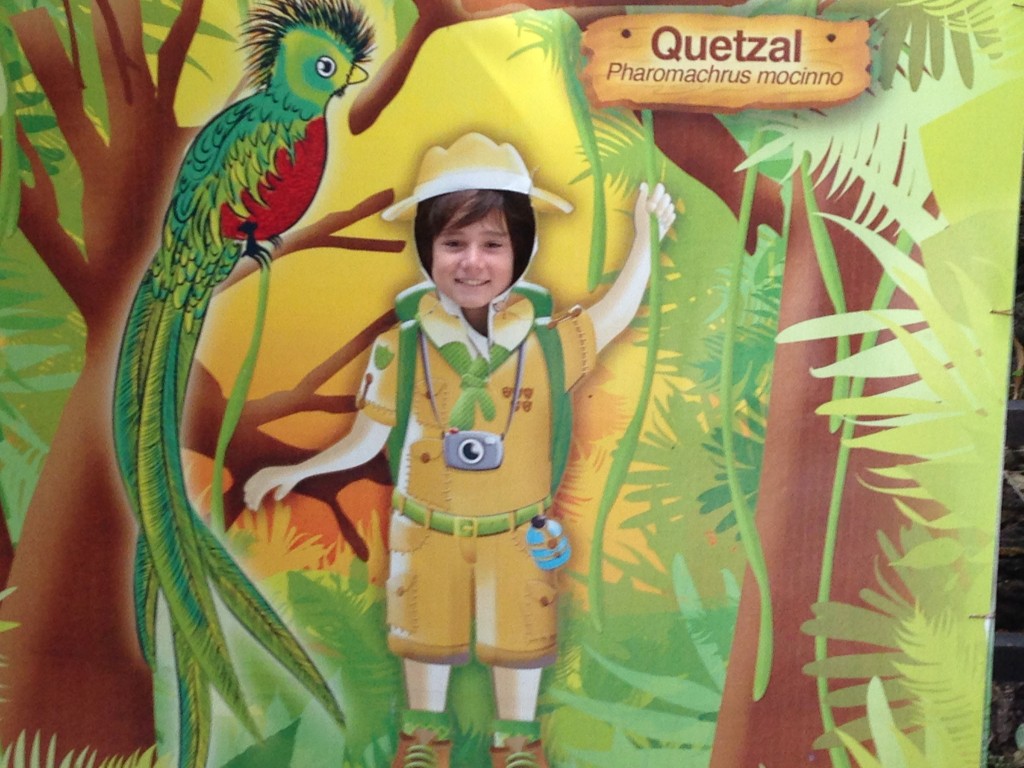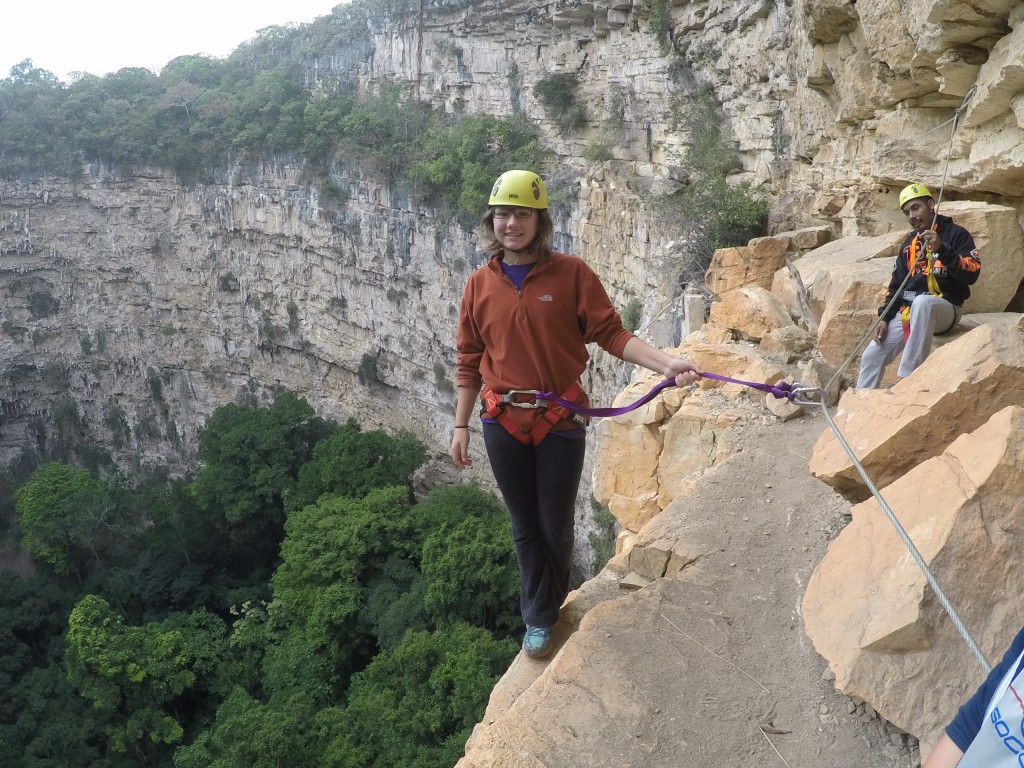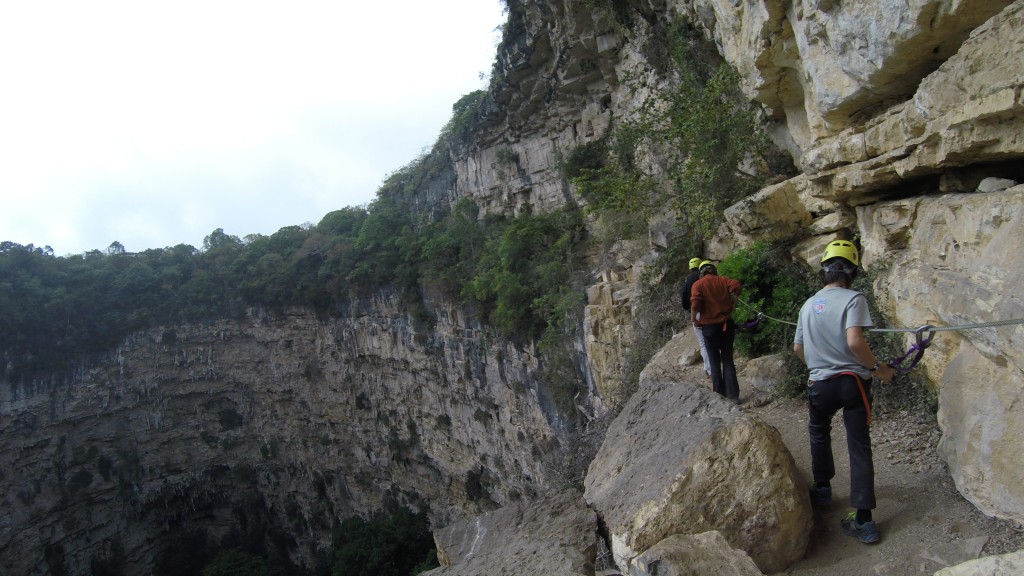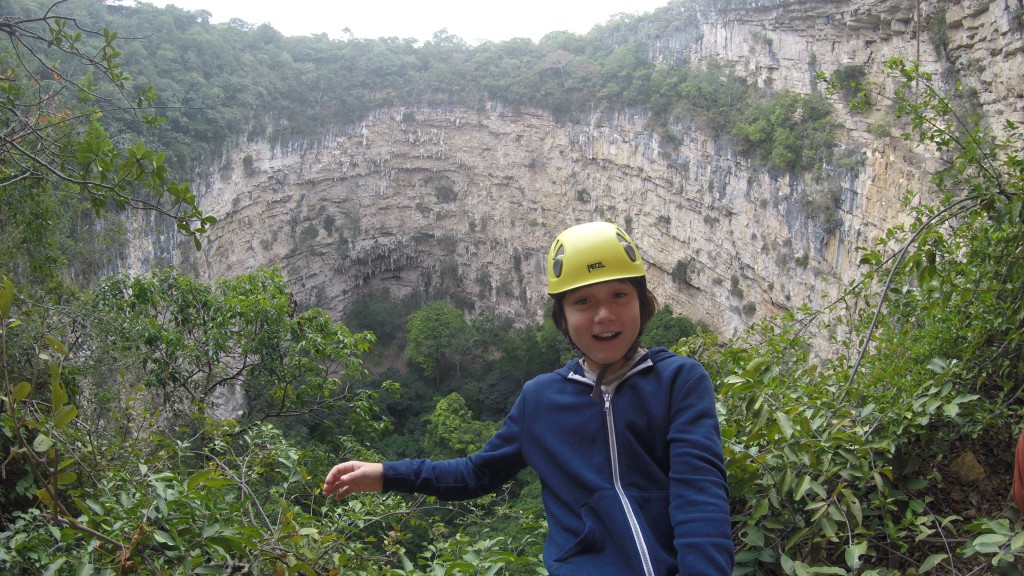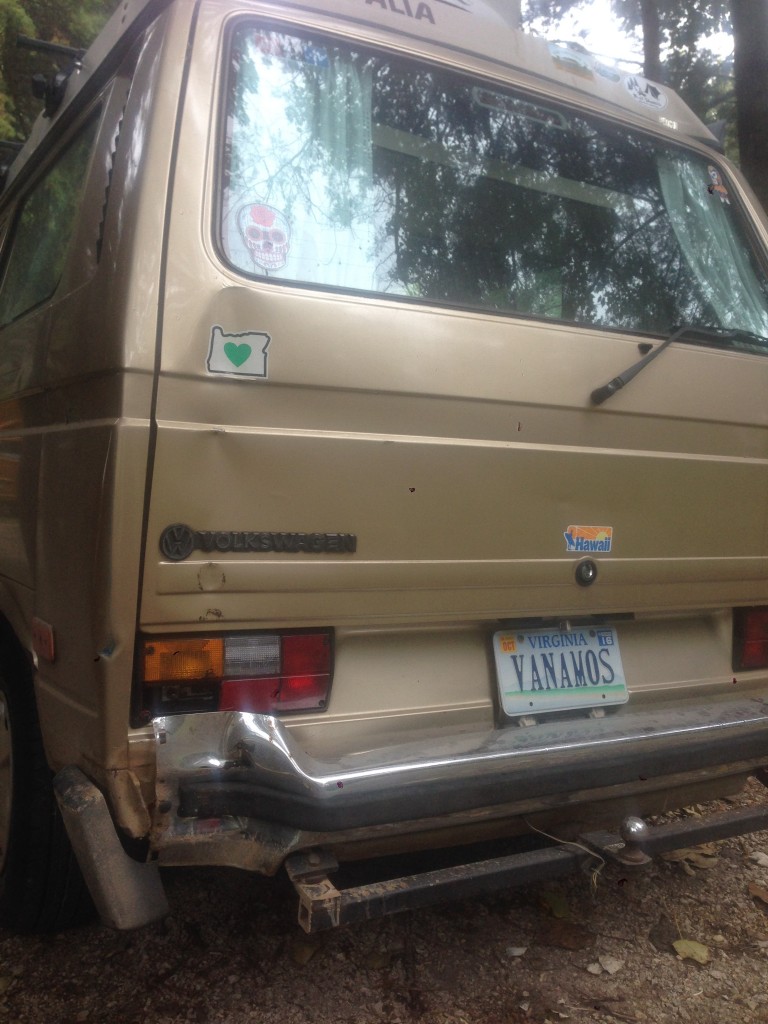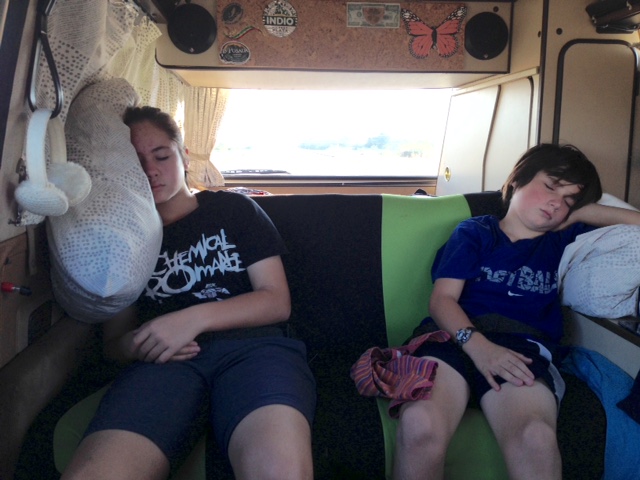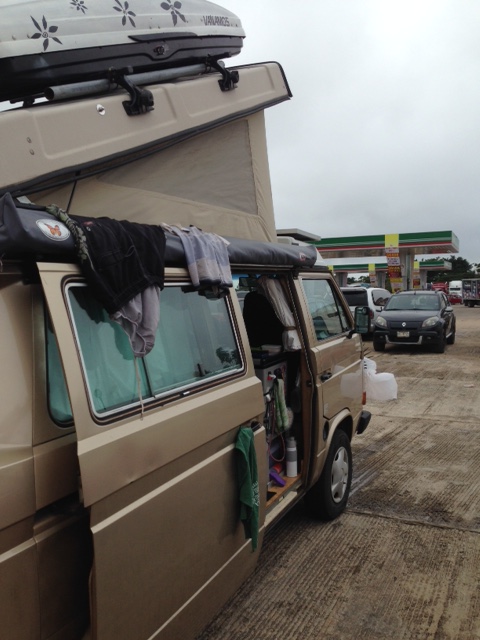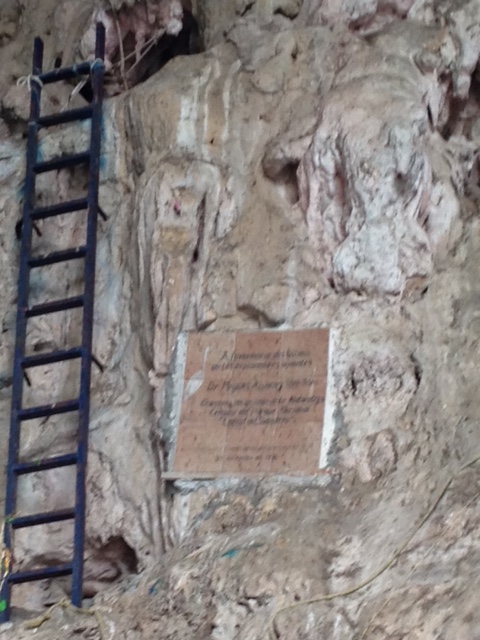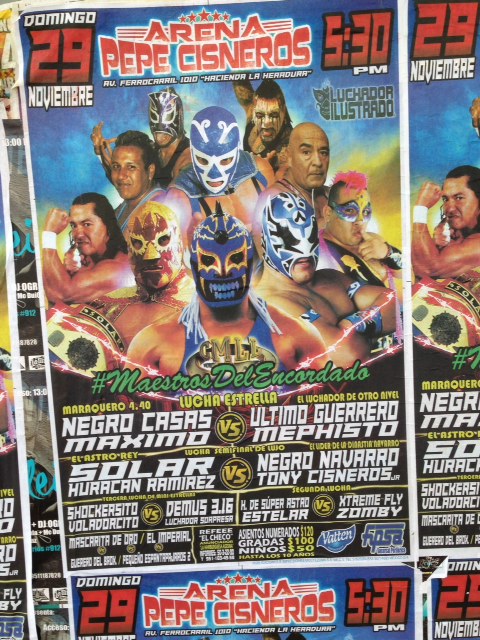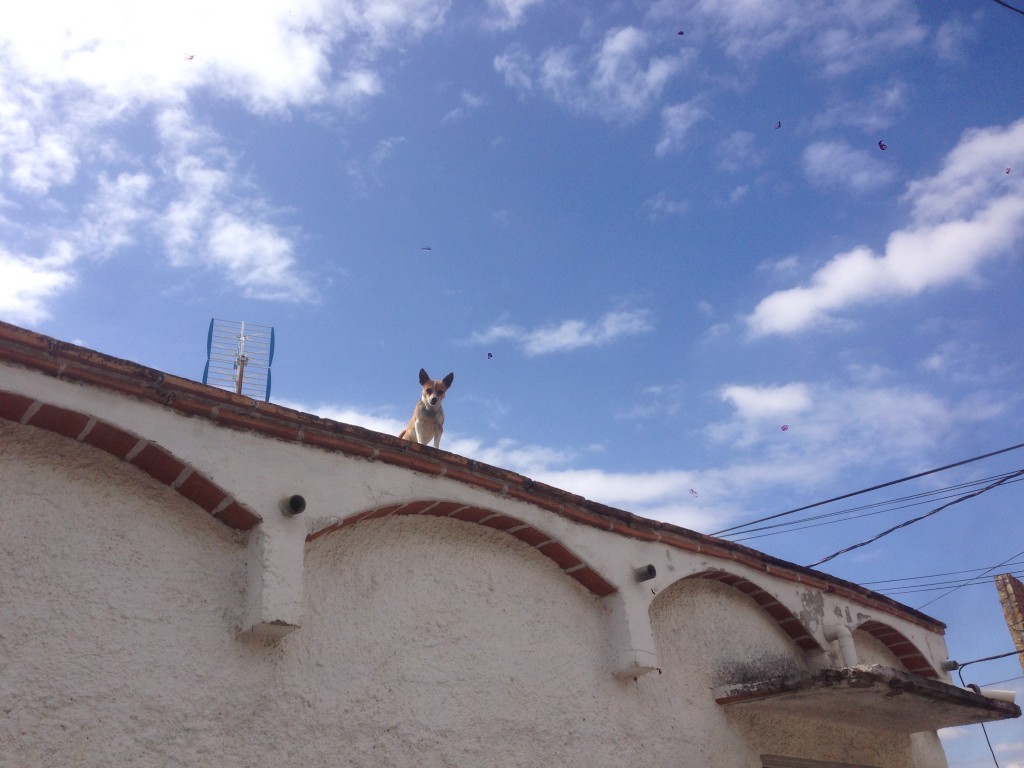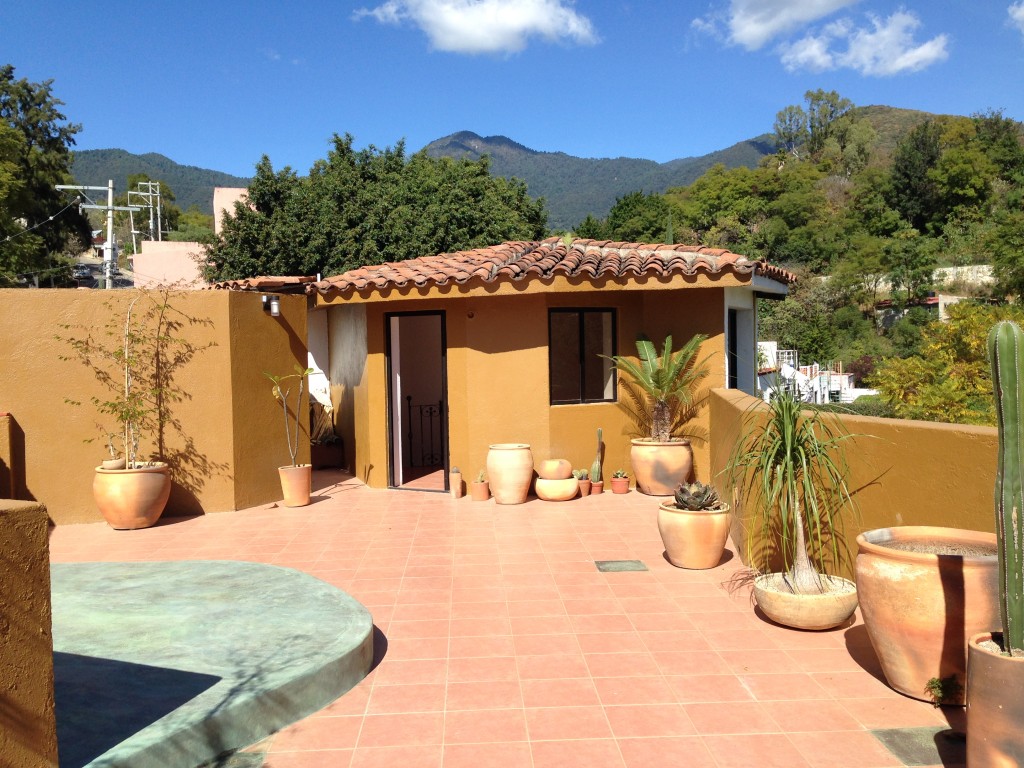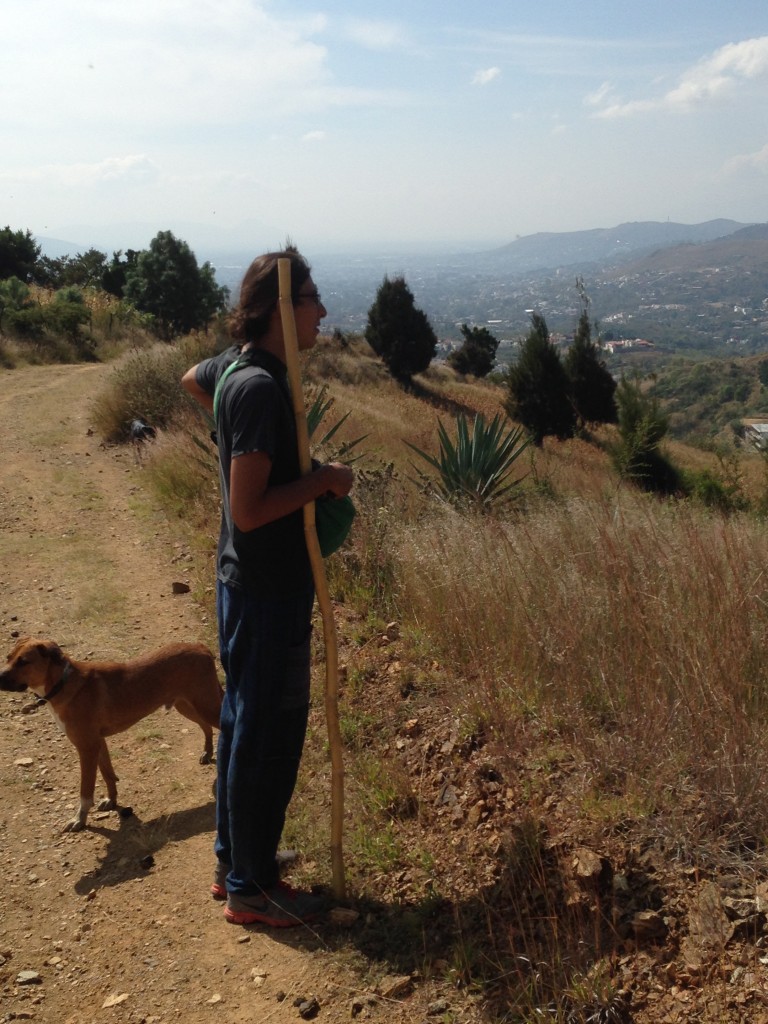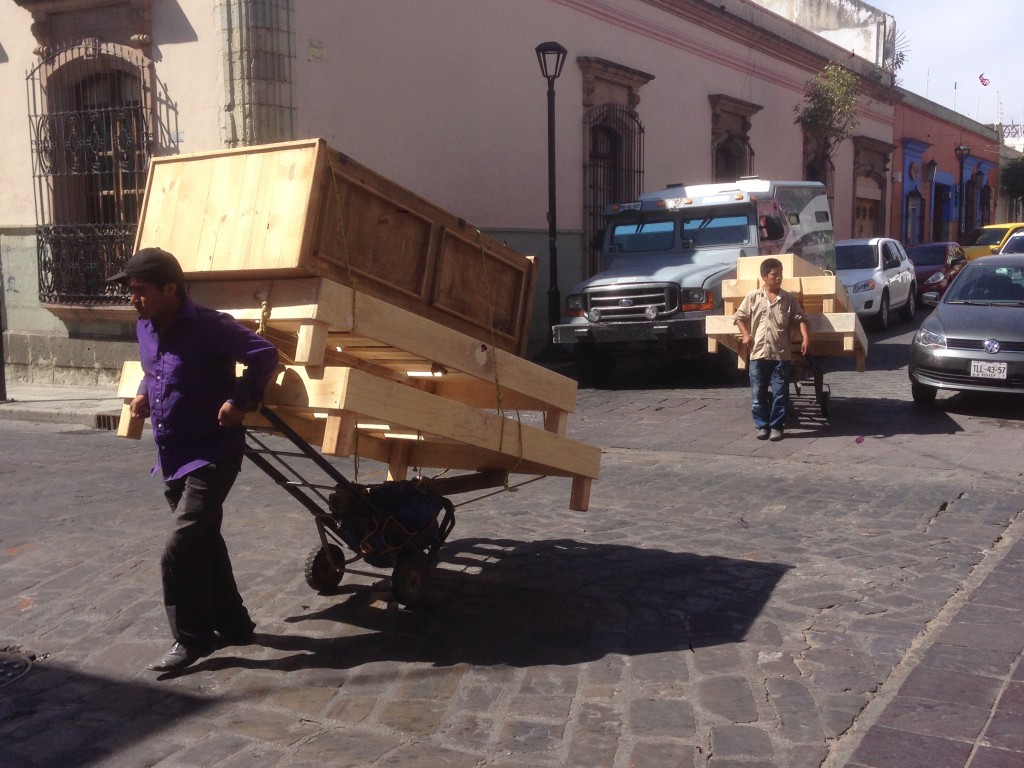In advance of our year on the road, we presented the Alexandria City Public School (ACPS) system with a thoughtful home school curriculum covering everything from animal migratory patterns to car mechanics that any self-motivated student would be thrilled and excited to study. ACPS stamped its approval and we went merrily on our way. What we didn’t consider was that we would not be bringing any self-motivated students along with us.
One Week and One Thousand Miles
Since we left El Salvador on June 9 we have driven Wesely over 1,000 miles across Guatemala and Mexico and I’ve got the driver’s tan to prove it - my left forearm is as red as tomato soup. It’s not our style to blow through places so quickly, but at this point in our year long trip we are focused on getting back to Alexandria for better or for worse. Despite our accelerated pace, we’ve managed to squeeze some fun in between our long driving days.
The Hardest Part
We thought leaving behind our responsibilities and driving overland through the Americas in a 1985 VW Westfalia camper van would be endless servings of strawberries and cream. But it has turned out to be a lot harder than we expected. I often find myself thinking of what our new friend Claude said to me one night as we washed our dishes in San Cristobal, Mexico. Claude is Swiss and has been driving around the world with his wife for almost fifteen years. He said, “Everyone at home thinks we’re on vacation. But this is hard work.”
Now, to be sure, this is not work in the sense that my shift starts at 9 a.m. and the boss is going to be pissed if I’m late. One of the liberating things about this lifestyle is that we have the complete ability to do whatever we want. If we want to go to the waterfall to swim today we can. Or we can do it tomorrow. If we want to go to Mexico, or stay in Guatemala, the choice is ours.
Palenque with Kids
When I was a kid I had a book called “Wonders of the World” and I would sit and stare at the pictures it had of Mayan temples half covered by jungle or poking out of the trees and wonder about the people who lived there and what they were like. I imagined walking through the brilliant green fields beside the towering temples – obviously not realizing that the temperatures would be sweltering and the rain plentiful - and exploring the labyrinthine passageways inside. I wondered about details of life there that we will probably never know and the questions raised about this ancient civilization still fascinate me. Last Friday, this 45-year old kid got to visit Palenque, one of the major Mayan architectural sites in Mexico, which was at its artistic and militaristic peak from around 600-800 A.D.. The excavation work at the site which began in 1952 and continues today – only a small portion of this vast metropolis has been released from the clutches of a relentlessly encroaching jungle – has revealed a treasure trove of information for archeologists about this particular city and its place in the pecking order of contemporary, rival cities like Tikal and Tonina, and about the Mayan culture overall. Watching the mist rise from the tangle of trees and vines surrounding these magnificent yet crumbling buildings gave me chills and I realized I am still awed by the questions places like these put in my mind. What did the war chiefs talk about when they met on the patio of the war chiefs? How did the great Mayan ruler Pakal feel when he looked over the city from the portico of Temple IV? Where did enemy captives get their heads cut off? Why are my children so lame?
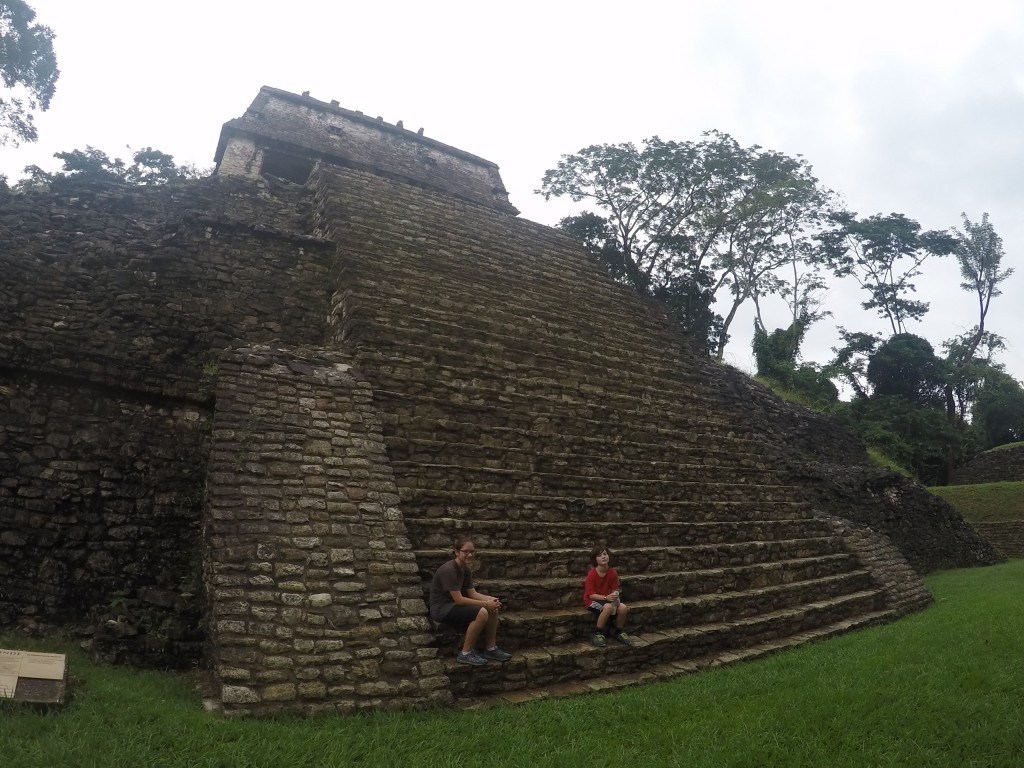
We were only about 30 minutes into our visit to the museum outside the ruins, which is air-conditioned, and contains intricately carved artifacts from a thousand years ago with funny faces and serpents coming out of their heads, all described in English, including an enormous sarcophagus where bones of the ruler Pakal were found, when Coconut declared she was bored. The extent of her curiosity about the site over the next couple of hours was to ask why the steps of the temples were so big when the people are so small in stature. J climbed 25 steps to the top of a building where a Count from Europe lived for a few years in the early 1800’s, and that was it. He and Coconut seated themselves on a rock at the edge of the Central Plaza and got drizzled on while R and I climbed temples and explored passageways and took in the views with amazement and wonder.
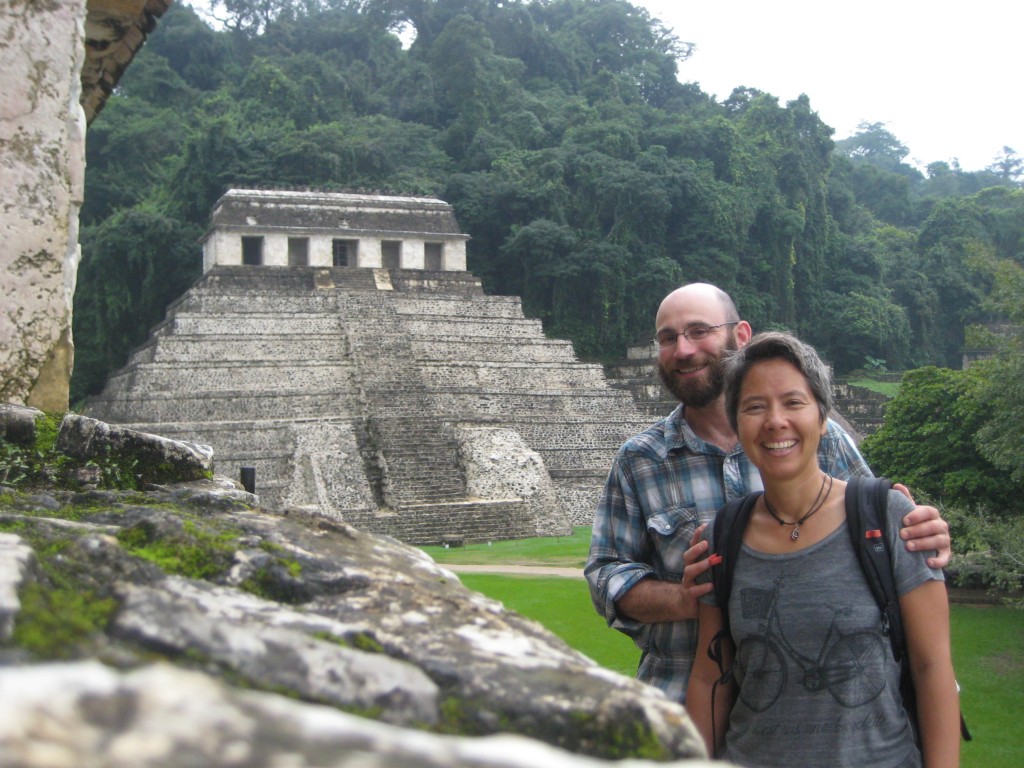
We were pissed – R was going on about how our kids were missing such a great opportunity and I agreed, comparing their lameness to the greatness of another pair of kids who were on a guided tour with their family and appeared to actually be paying attention and asking questions. If I had found the sacrificial table, heads may have rolled. But then the greatest thing happened - the sky unloaded buckets and buckets of rain at a rate of about 15 inches per hour. This, finally, caused Coconut and J to climb the 40 or so steps to the top of the Palace to seek a dry corner and eat the peanut butter and jelly sandwiches I had made for lunch.
The mood lightened even as the sky grew more overcast and dim. They still wanted to leave, but they let me go on a little bit about what I felt as a kid when I looked at pictures of the place in my book and how it made me feel to actually be standing there, and even agreed to walk the few kilometers back to our Maya Bell camp rather than taking a collectivo bus.
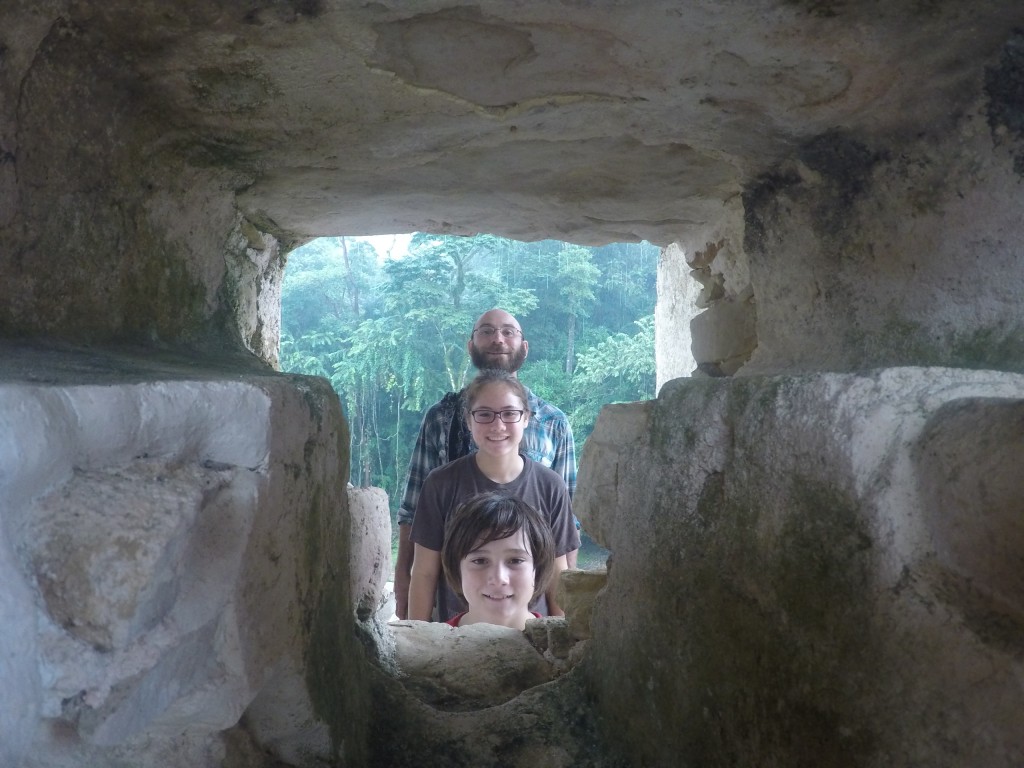
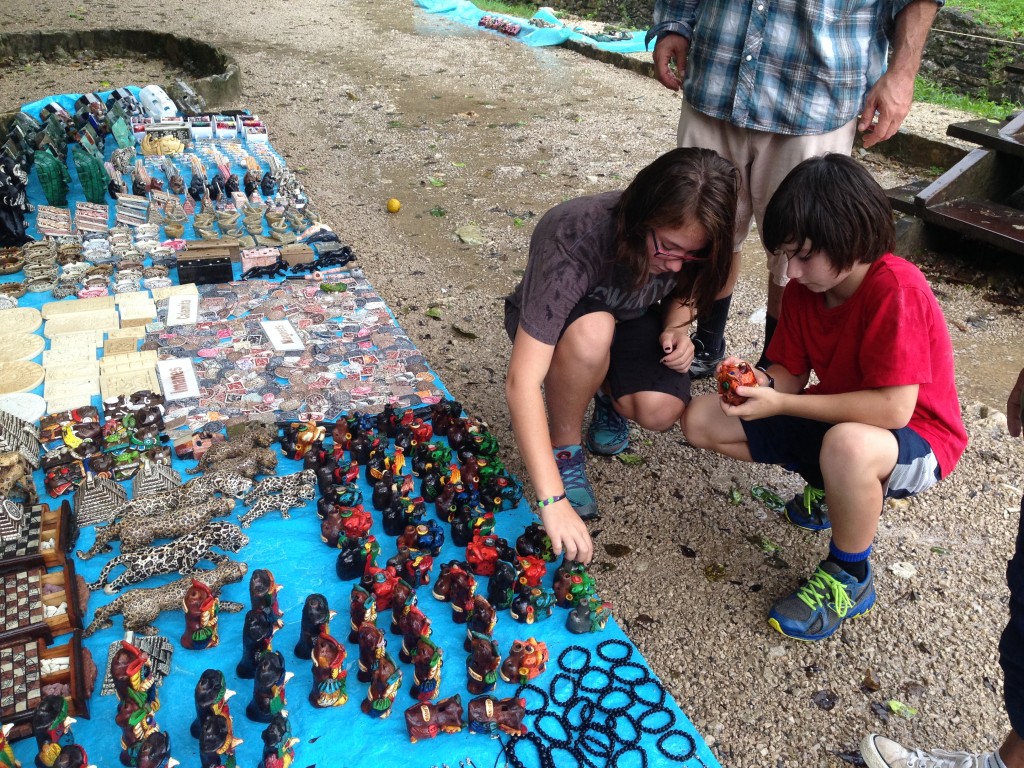
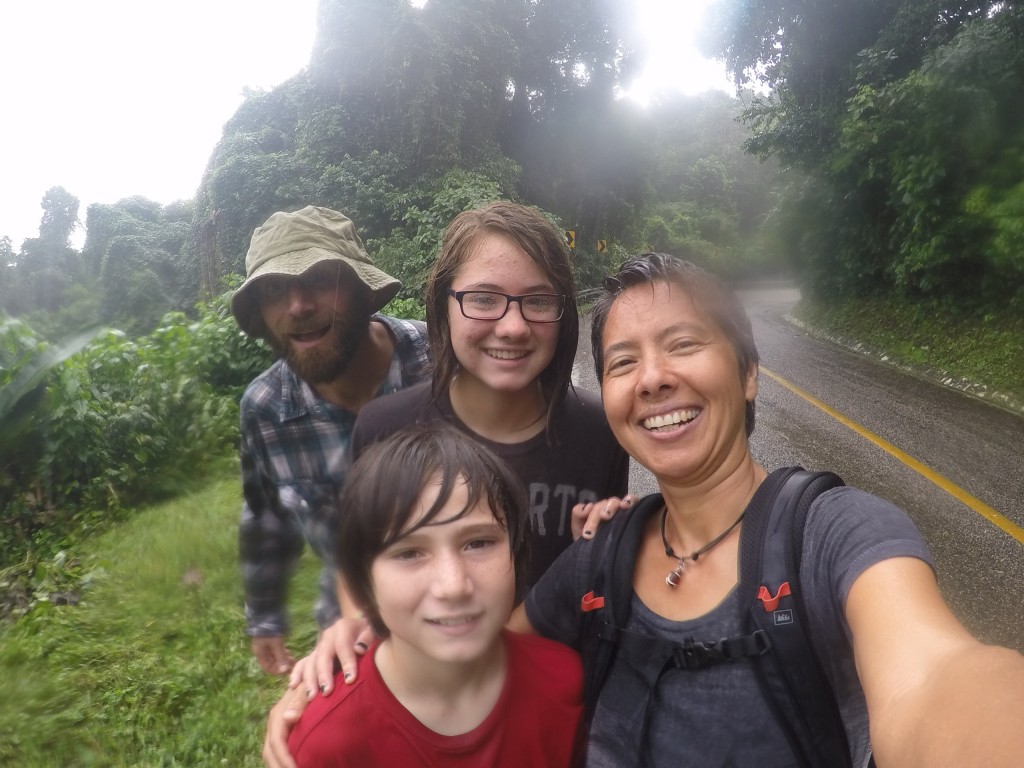
We hate camping in the rain, and even though Wesley is cozy and warm, R suggested that we pack up and head for the border town of Tenosique to spend the night. It was a good idea. Coconut and J showered, put on dry clothes, and played cards after ordering lunch at the restaurant while R and I packed our soaking gear as dryly as possible while the clouds continued to empty themselves so much that the pool overflowed. Finally, as we pulled out of camp, the skies cleared and the sun shone through – a good omen for our drive. If all goes well, we’ll be spending Saturday night in Guatemala.
The Long and Winding Road
We heard several things about the road from San Cristobal to Palenque – none of them that it was an easy drive. That the road was long and winding was no surprise - it was many moons ago that I anointed Mexico the most mountainous country I’ve driven. We also heard that the number of topes was extreme – two tope towns become four and five tope towns with no discernible difference in economic or scholastic opportunities.
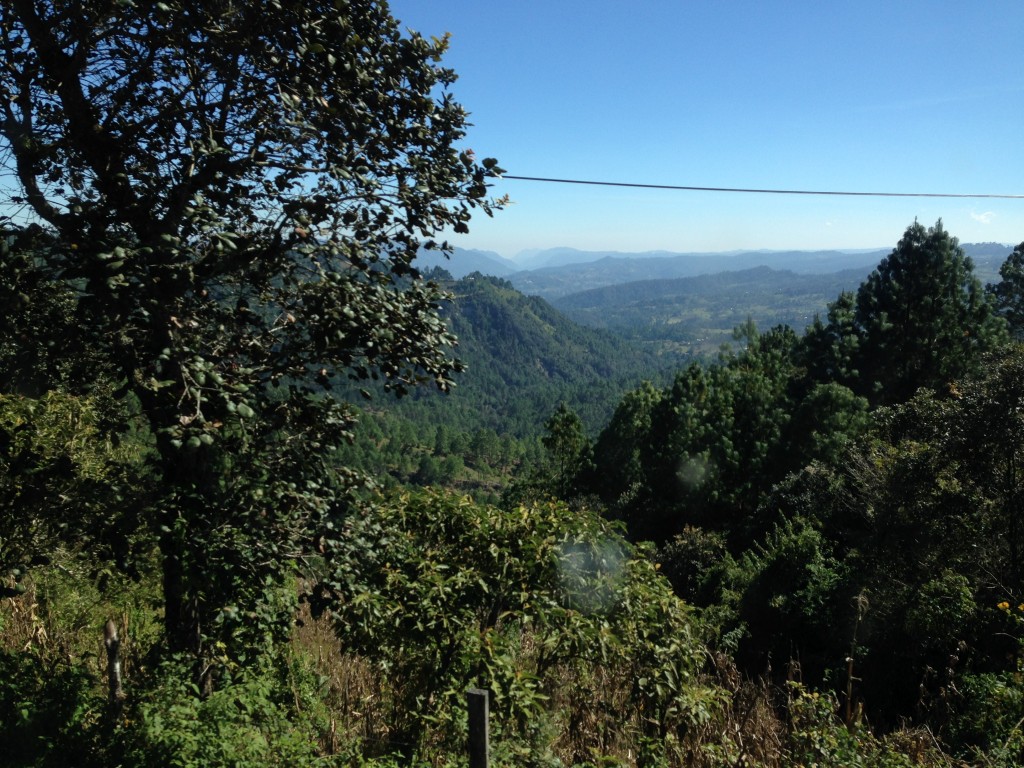
Finally, and most concerning, was that we could encounter road blocks along the way that could hold us up for hours if we weren’t willing to pay the “toll” - something like 50 to 200 pesos, depending on how well one can negotiate. Chiapas state has the highest population of indigenous peoples in Mexico and therefore, has the highest population of disenfranchised peoples. As we drive around we point out to Coconut and J all the old men and boys clearing the fields and tending the animals and the women and girls selling fruit, corn, and trinkets on the street, and they know how lucky we are for being born into the circumstances that we were.
The thing is, even though the people are breaking their backs in the fields, they aren’t seeing all of the fruits of their labors because they don’t own the land. It’s the story of how the rich get richer and the poor get more bent over. So, every once in a while the poor will set up a road block on the main road to Palenque to stop traffic – primarily trucks hauling freight – to protest their condition. I don’t know if anyone in charge who can change their plight notices this and wants to fight for them, but a side benefit is that by stopping traffic, tourists like us who have nothing to do with anything, can pay a toll to move along.
Coconut was actually excited to be stopped like this, but after all the build-up and anticipation – it’s one of the first topics of conversation among overlanders coming from or going to Palenque – we didn’t encounter a road block. I was a bit disappointed as well, because depending on where the road block was set up, I thought we might be able to get an oil change for Wesley while we waited.
A few times during our drive a mom and her dirty and sweaty kids would string up a line as we approached and try to sell us fried plantains or sugar cane for a few pesos. When we didn’t buy any of their stuff, we would hand out a few toys from the bag of junk that we brought with us for this purpose – matchbox cars, erasers in cute shapes, super balls, colored pencils, and the like.
There are a few stopping points along the road to Palenque and the first night we camped at Agua Azul, a series of waterfalls tumbling over rock crevices into pools perfect for a refreshing dip. We’d been in the highlands for the better part of two months so the jungle setting of the falls was a reminder that heat and humidity suck, but at one point after splashing around in the water on a rope swing, J was shivering and we said we would remember that feeling later that day when we were sweating again.
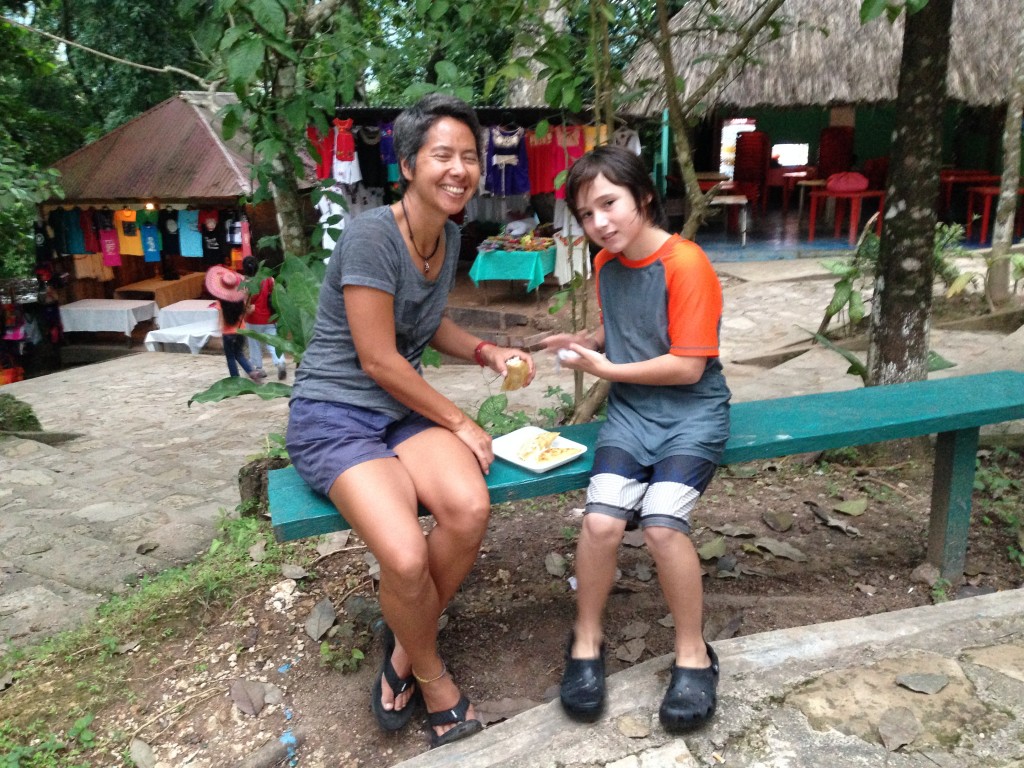
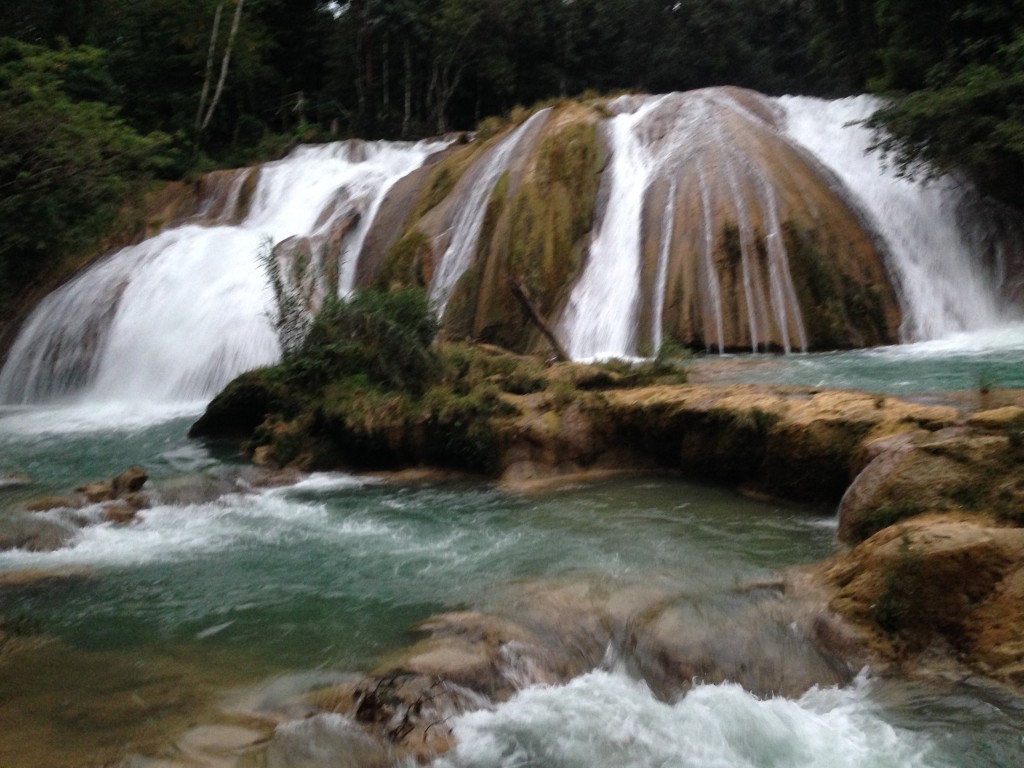
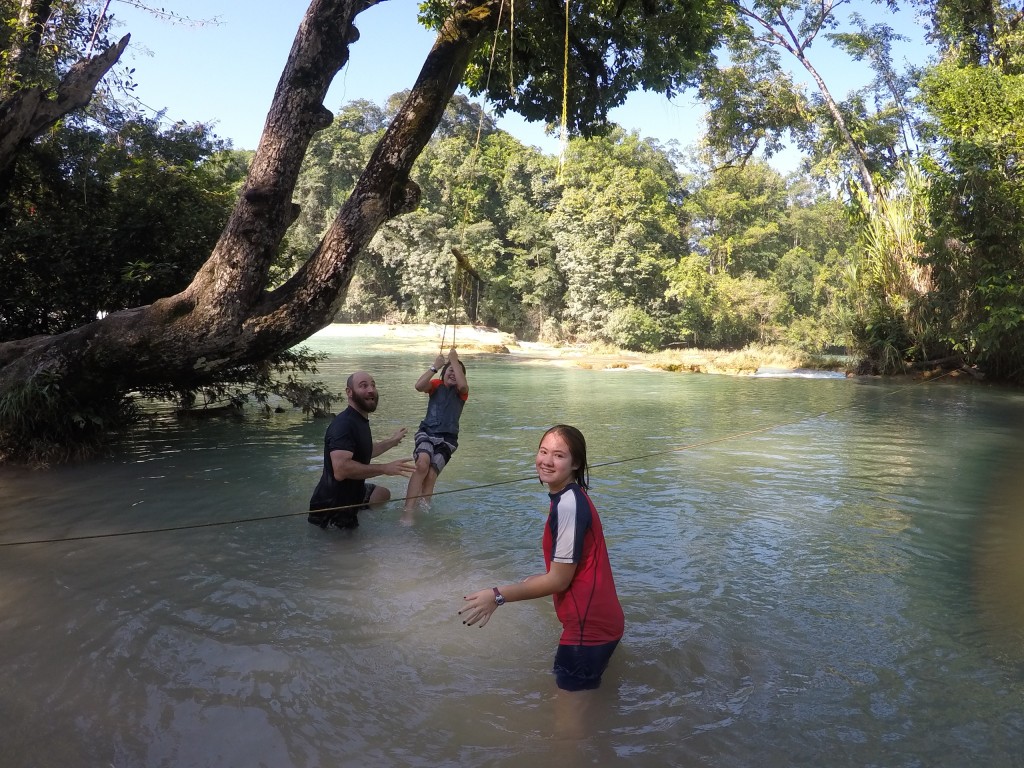
The camping at Agua Azul was pretty basic – no showers and toilets without seats that were closed after dark when all the restaurants and vendors hawking artsy-fartsy stuff went home. A bunch of people drinking beer pulled in right next to us and R was pretty annoyed so went to bed around 7 p.m. but Coconut and J decided that with the sound of the falls, we could hardly hear their noise. After a few hours the police came and chased the party away – the most effective bit of police work that I’ve seen in Mexico.
The next day – Wednesday – we stopped at Misol Ha, another waterfall with some caves behind it that we paid ten pesos each to enter to see the bat cave and underground waterfall. It was pretty cool. Then R and J and I swam in the pool in front of the main falls for a while before driving on to Palenque and the Maya Bell campground where there are still no toilet seats on the bowls.
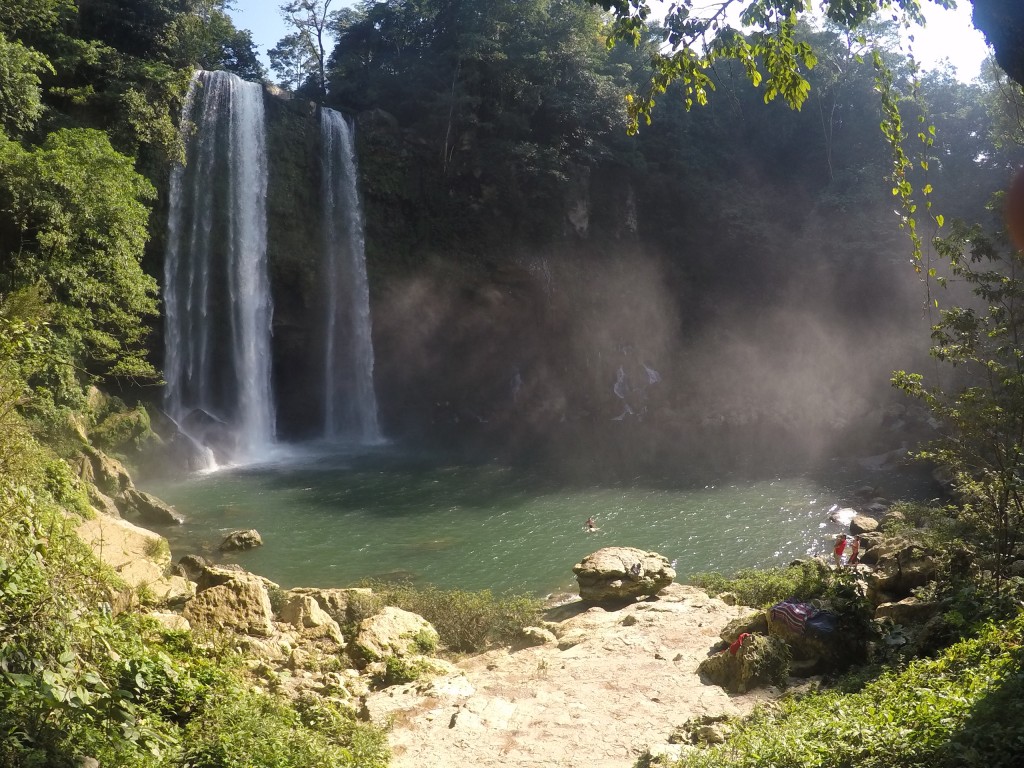
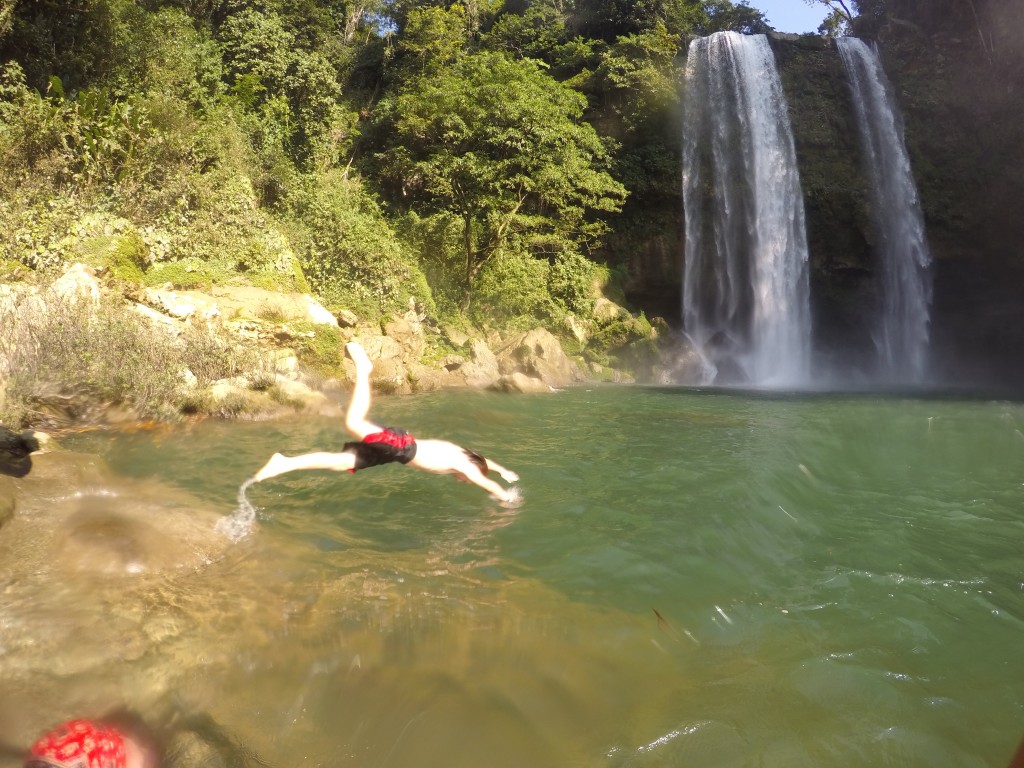
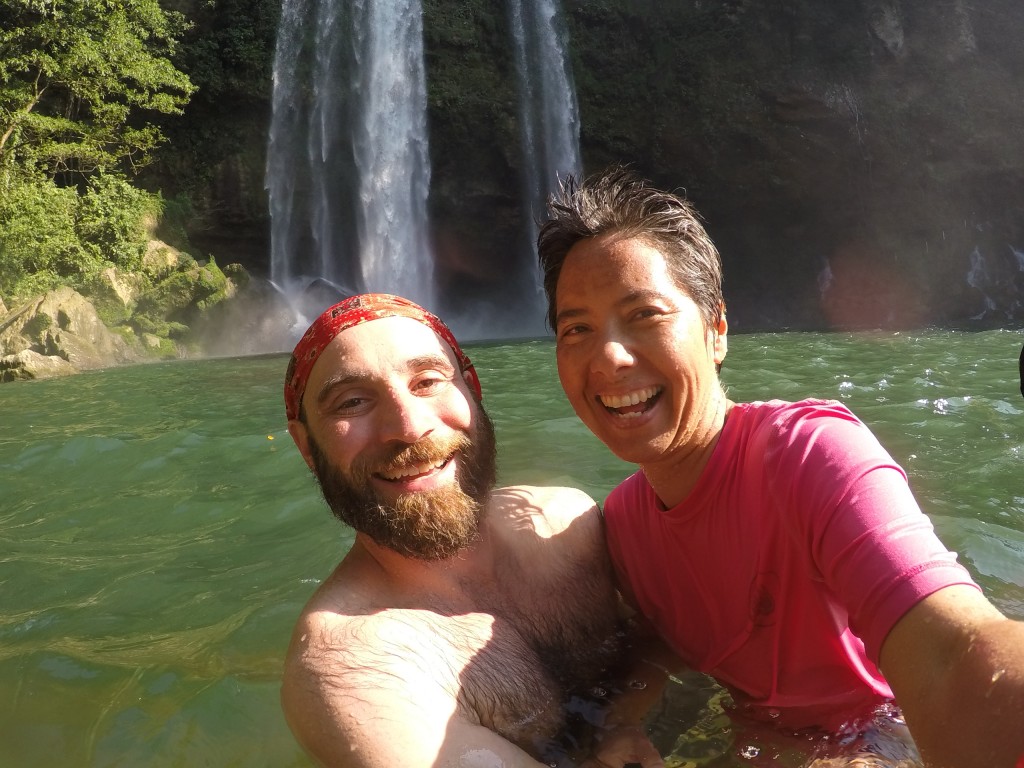
There are biting ants, however, and when Coconut and J are not in the pool or scanning the tree tops for howler monkeys, they are holed up in Wesley. J has become super sensitive to bugs and when he and I were leaving the bathroom, he spotted a cockroach so I started singing – la cucaracha, la cucaracha. He asked me who sang the song, but I didn’t know; I said that it was just a folksy song and not a song written by a band that made records. He raised his fist and said, “Yeah, I bet people didn’t sit around at Beatles concerts going, 'yeah, play La Cucaracha, man!'”
A Change in Plans
We left Alexandria, Virginia, on August 1, with plans to be in Belize City on October 2. Coconut and J’s grandparents wanted to meet us somewhere and Belize in October seemed reasonable, though I’m sure we never looked at a map or actually figured out how many miles away it was and how many hours of driving would be required. R and I aren’t that type of overlander - detail oriented. We just kind of go with our gut. On September 16, when we were still stuck in Zihuatanejo, a great Mexican beach town on the Pacific side that we had stumbled into a week earlier without any idea of what we were getting into, we did the math and figured that Belize was still about a million miles away and that we could never get there in two weeks and a few days so we had a change of plans and took R’s parents to San Augustinillo, a different Mexican beach town on the Pacific side.
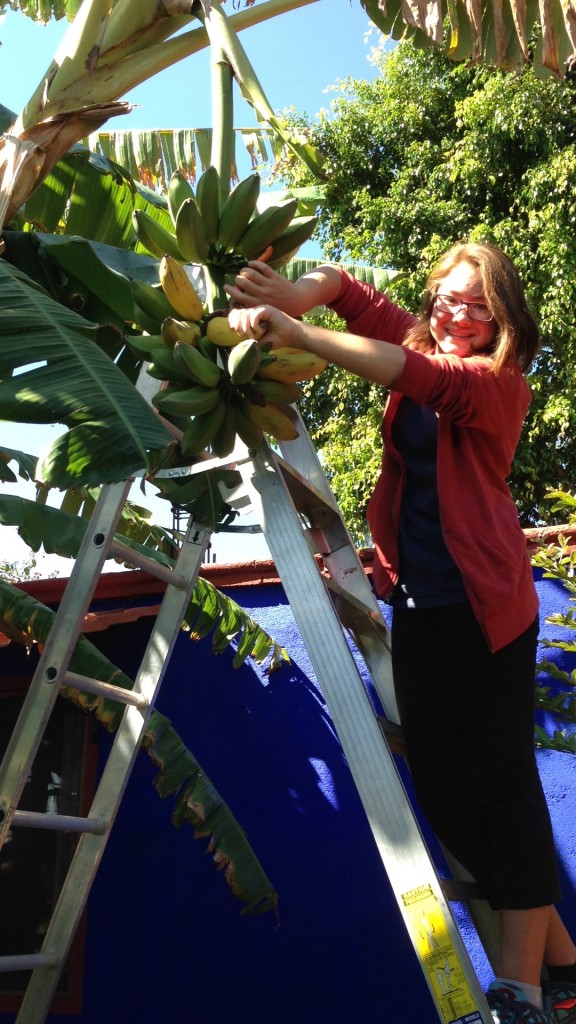
A change in plans – that’s pretty much been the story of our trip. By Christmas we thought we would be in Panama. Instead, we might leave Mexico and be in Guatemala. We spent our first week in Mexico at La Posada, north of Monterrey, where we only planned to spend a night. We spent four nights in San Miguel de Allende because we were having fun with Sean and Mittie, a whole week at Zihua; seven nights in Puerto Escondido; more than a month in Oaxaca; and now, a week plus in San Cristobal de las Casas which I was pretty much ready to skip except for a hot shower and hotel room pillow.
We crossed the border into Mexico on August 26, and if you add it all up, we’ve been here for more than 15 weeks when we only planned to spend about six. Overindulgence has always been part of my identity – too much of everything is just enough, as the Dead sing in “I Need a Miracle” – but I didn’t expect Mexico to grab me by the huevos like it has.
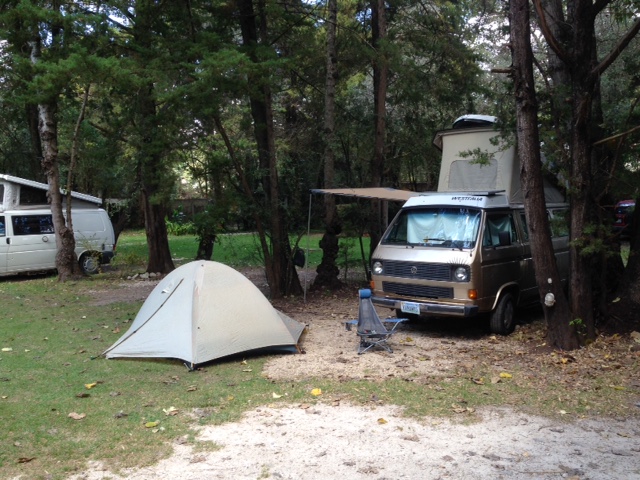
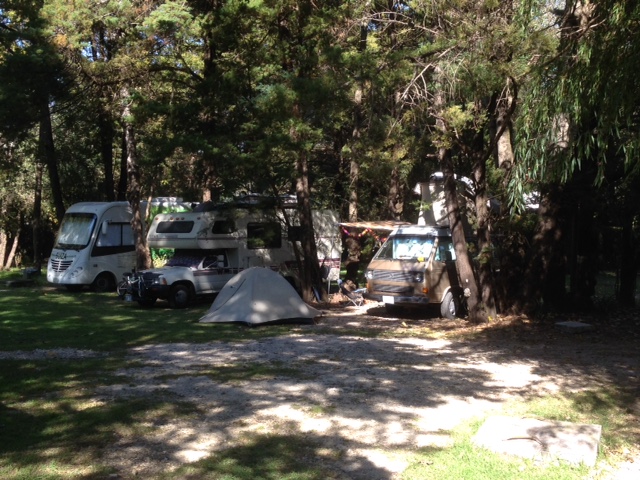
The natural beauty of the country is unbelievable – like nothing I have ever seen. Driving roads where the horizon lays out mountains on top of mountains is terrifying, okay, especially when you are driving the equivalent of a tricycle, but once you get past that, the feeling that vista gives you is tremendous - you feel wild; unhinged. Like anything can happen but it will all be fine. And the people are so friendly. How often have you said, “Hello. Good morning” to every single person you passed on the street, including those riding by in a taxi and the driver? And had it returned? Americans' perception of Mexico is so skewed by media portrayal that we should sue for libel. Is a bunch of guys standing on the corner drinking Coca Cola and eating grilled corn on the cob threatening to you? How about when they all raise their Styrofoam cups in recognition, genuinely smile, and say “Buenos noches”?
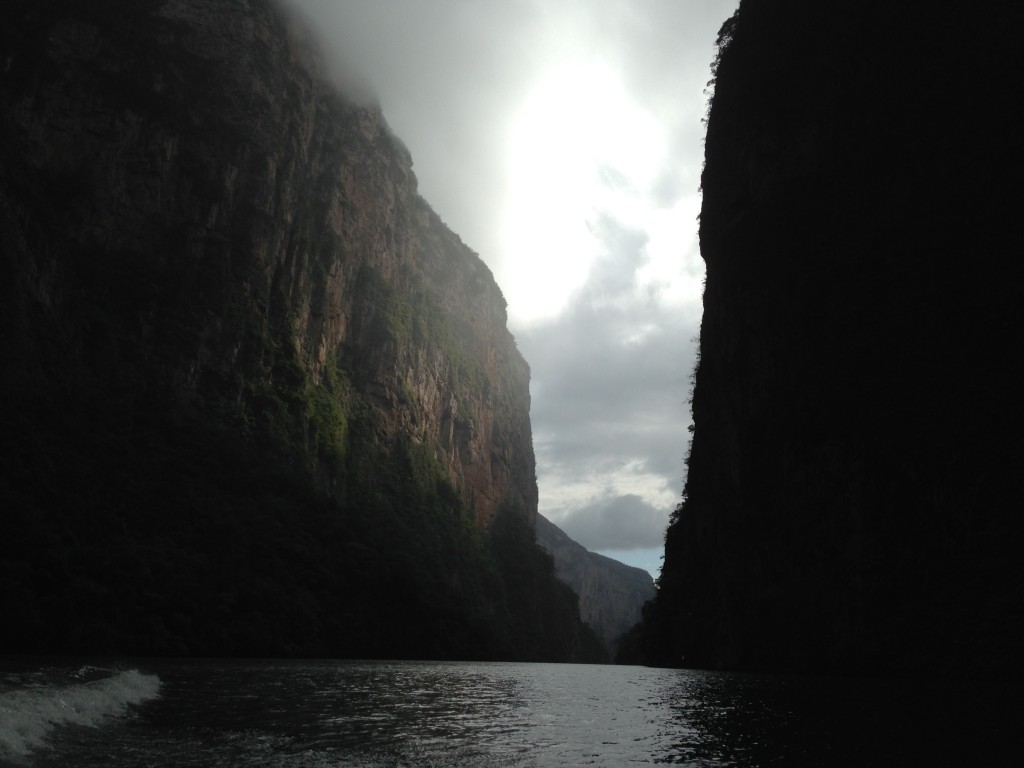
So, our plans have changed a lot and we’ve had a hard time getting out of Mexico. We haven’t needed an explanation because we haven’t asked any questions – we go with our gut. Along the way we’ve run into other folks who are wobbling from there to here, but no matter what song they’re singing, when we tell them how we’ve got stuck, it’s the same refrain: you’re doing the right thing. There’s no place like here and there’s no place like now if you’re enjoying yourself.
And we are. Since we arrived on Sunday at Rancho San Nicolas, with plans to spend a night or two, a family of four from Canada has pulled in next to us. An older couple from Switzerland who has been here before pulled in next to them, and a young couple from Switzerland who has not been to Mexico before but took 14 months to drive up from Uruguay pulled in next to them. This has driven the American who has been here for the last month to the corner of the grounds – not because he’s not social, but because too much English spoken outside his window breaks his concentration while he finishes his novel. On Friday night, we all went out to dinner.
On Friday morning I took a walk on the path that leads steeply up from the campground, crossed a few barbed wire fences to the top of the hill, and gathered my breath while I watched the mist rise from the fields. I came down along the road and took a path that led to a river where I saw an old man gathering sticks like gold from the bank to put on the fire where he was heating his breakfast. When I arrived back at camp at 8:30, J was in the common room. He had started a fire in the fireplace and was playing pool with his two new friends. Coconut, who will be a teenager on Monday and has been acting like one lately by sleeping to 10 a.m. or later, was not far behind. Before lunch, she was demonstrating to the boys how to draw a bow to shot an arrow, and actually joined the Wiffle Ball game, which the young Swiss guy joined too, after sitting and watching us for about a minute.
Coconut told us later in the day that she wanted to stay here until at least Tuesday. We planned to start our drive to Palenque, a major Mayan ruin, on Sunday, but now - what the hell? We may have lots of questions about what we’ve done, and what we are going to do, but there are no regrets.
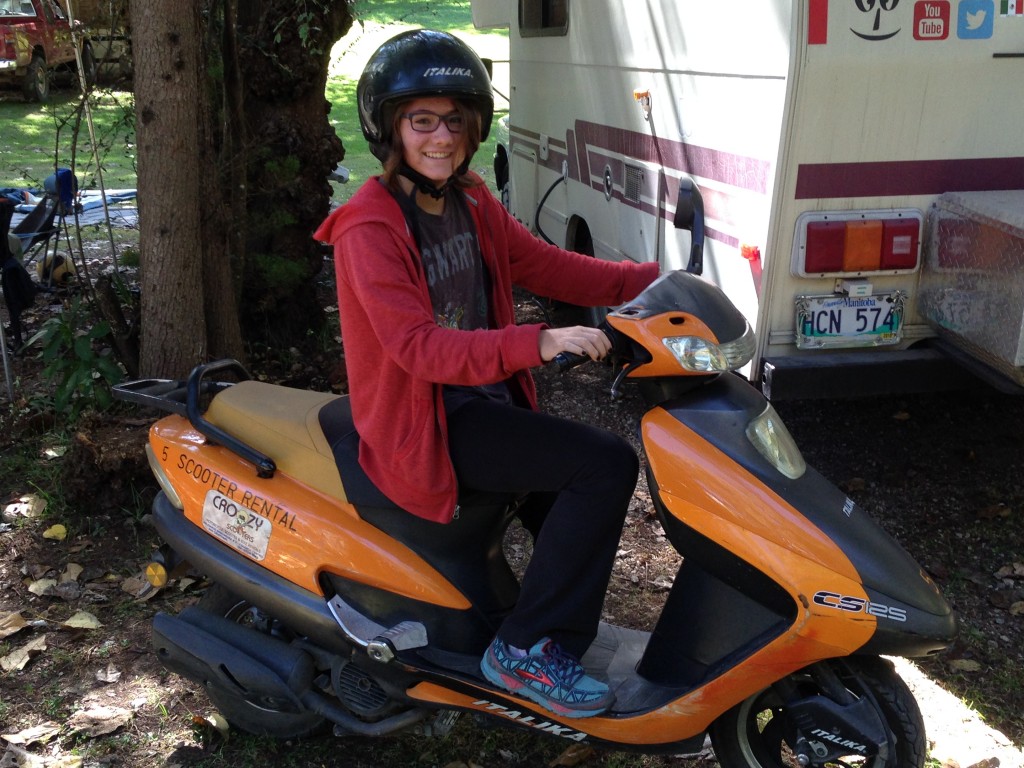
Crazy Town
Chiapas state has the most independent-minded indigenous culture in Mexico. Parts of the state were never fully subjugated by the Spaniards, and several tribes continue to deny Catholicism as the national religion and not pose for tourists’ pictures. The state even rejected joining both Mexico and the United Provinces of Central America subsequent to the eviction of the Spaniards in the 1820’s before deciding by referendum to join Mexico. We’ve witnessed some of that edginess during our short stay in San Cristobal de las Casas. We arrived during the week long fiesta for the Virgin of Guadalupe, who is the patron saint of Mexico, and she apparently requires that the band start playing at five a.m. to the accompaniment of exploding sticks of dynamite and someone yanking on the church bell 100 times every fifteen minutes. Despite the constant drizzle of rain, uncharacteristic, we are told, the people’s spirits, and the fireworks’ wicks, have not been dampened.
We didn’t plan to stay in San Cristobal for long, having just come from an extended stay in a colonial city (Oaxaca), but I ran Wesley into a telephone pole so we are grounded for a few days while it gets repaired. As we drove to a body shop recommended by someone that we just met, I described to Coconut and J how the repairman would drill a hole into the middle of the dent, insert a tool that would splay out from the inside, and then pull the metal back into shape. Instead, the body guy comes out into the rain and mud with a heavy mallet and a piece of two by four and starts banging away. In an ironic twist, he thinks he might have the van a few days so he can get the paint to match. A perfectionist.
After watching this spectacle for as long as we could take it, we started walking back to town. At a busy intersection, we saw a kid - a teenager - with a plastic liter bottle filled with gasoline. He took a swig from the bottle, spewed flames from his mouth, and then daintily dabbed his lips and chin with a greasy rag. It looked really cool, but was a depressing thing to witness. We gave him fifteen pesos. I told Coconut and J that if they ever needed money that badly they should come talk to me no matter how grouchy I am that day.
Later, while we were eating lunch at the fanciest pizza place in town, a parade came marching through the main pedestrian street. We quickly ran to the balcony of the restaurant to watch and saw an older man at the end of the line nonchalantly lighting bottle rockets with his cigarette and launching them from his hand like he was Cape Canaveral. We didn’t feel nearly so badly about this - in fact, we could hardly stop laughing it was so funny.
The fireworks culture in Mexico is quite different than what we are used to. Explosions are mandatory for any celebration, and ubiquitous at all other times. I think the school principal will often set off a rocket in lieu of opening bell. R and I had fun shopping for cojetes before our Thanksgiving celebration and the kids had fun setting them off - under my supervision, of course, for whatever that is worth. When J had a friend come over for a play date, lighting off fireworks was the featured activity.
Anyway, the rebellious strand that permeates life here seems to have trickled over - this morning even R, a notorious pacifist, got into the act. When the first volley of gunpowder was detonated outside our door several clicks before sunrise, she rolled over and said, “I’m going to kill them.”
Indian style in San Cristobal de las Casas
Since Mexico gained independence from Spain in the early 1800’s it has survived several invasions by other countries, including the United States in the Mexican-American War, and internal uprisings due to bad government that has caused it to change heads of state more often than the wind changes direction. Many of these civil wars were instigated by indigenous peoples seeking equal rights, particularly with respect to land holdings. In fact, as recently as the 1990’s, a rebel group called the Zapatistas engaged in an armed insurgency as a means to bring about social reforms for indigenous peoples in Chiapas state, where Wesley is currently parked. In some cases these uprisings bring about social reforms that redistribute land ownership to ejidos - community land holdings - for local groups native to the region. On Saturday night, we arrived at Sima de las Cotorras, an ejido of the Tzamanguimo people - who must be ancestral to Chiapas.
The Sima is an enormous sink hole in the ground, dating from who knows when, and its recent claim to fame is that it is home to several hundred green parrots which spew forth from the ground like feathery lava each morning and seep back at dusk, but only during the months from April to October. In December, the parrots are sunning themselves in warmer climates; but nobody told us this, so we bounced our way over 12 kilometers of rocks and mud to camp in the rain and cold. No matter, because the chances that we were going to be able to wake at dawn and hike the few meters to the sink hole to see the birds as they greet the day was really quite slim. Instead of seeing birds, we justified our visit to the Sima by taking a stroll around the perimeter of the interior of the hole on what we called a “danger walk”.
Being on the ejido, and witnessing what the folks have done with their opportunity to own land - nicely maintained grounds, well-built and kept cabanas, good restaurant, something to keep their children home and to take pride in - led to a Vanamos breakfast conversation comparing Native Americans with Mexican indigenous peoples.
Now, I’m just a guy with too much time on his hands, so none of what follows should be taken as gospel, but just some general reading I’ve done has learned me that before the Spaniards conquered what they came to call Nueva Espana, the native tribes like the Aztec and Maya had settled in great cities and when they warred with neighboring cities, they sacrificed the captured warriors by cutting out their hearts, or chopping off their heads. Native Americans, like the Lenni Lenape and the Apache, did not build cities but generally moved around the plains or forests depending on the season. If they got into a disagreement with a neighboring tribe, they organized a raiding party and, under cover of night, stole some of the other tribes’ horses. Comparatively, this is the equivalent of bullying the other tribe for its lunch money.
When the Spaniards came to Mexico they were viewed as bearded gods and were thrown great feasts and given women as concubines. Then they conquered and enslaved the men and took their land and its riches. When the first settlers came to America, they wore white socks pulled up to their knees and patent leather shoes. They tried to befriend the Indians because they needed their help to understand which crops to grow or else they would die. If the Indians were unfriendly, the settlers lived inside forts that they built out of sticks, just like the second little pig.
When the Mexican Indians got fed up with the Spanish Imperialists, a priest led them in revolt and they kicked them out, but this didn’t work out any better because the Church came into possession of the land. In the 1850’s, the Zapotepec politician Benito Juarez, one of the unsullied heroes of Mexican history, passed reform laws that required the Church to sell the land, but this didn’t work out any better for the natives because most of the land was purchased by rich people - not by historically oppressed peoples - and the rich people continued to exploit the natives and combat further reforms that would improve the natives’ station. This has continued to create unrest, and as recently as 1910-1920, Mexico was still engaged in widespread civil war to redistribute hacienda land to the natives. The natives haven’t owned their ancestral lands since the 1400’s and basically, they are pissed off about it. Occasionally, they get thrown a bone in the form of an ejido and it’s nice to see them take hold of the chance to preserve it in a way that the Tzamanguimo have done with the Sima.
On the other hand, as the American settlers became more comfortable with the land, and imported more guns and people, they pushed the Native Americans further and further west, signing treaties along the way that promised the Indians several shiny necklaces and a lifetime supply of alcohol. Eventually, the New Americans got tired of that game and created reservations in god forsaken places like Oklahoma where they forced the Native Americans to live with no economic options but to sell tax-free cigarettes and build casinos.
Well, it was an interesting conversation that we had, and Coconut even asked some questions about why Indians build casinos that reminded me of a very good book that I read called “Revenge of the Pequots” which details the history of Indian gaming starting from the Seminoles’ bingo parlors and the State of Florida’s unsuccessful efforts to tax the profits. The Pequots are a Native American tribe from Connecticut that was forced to open Foxwoods Casino and book multi-million dollar acts like Keith Urban and Nickelback, which is why you have probably never heard of them, but other tribes have heard of them which is why they all want to open casinos and get rich too.
Anyway, after our danger walk and lunch, we got in Wesley and drove a couple of hundred kilometers south and 1,940 meters up into the clouds, literally, to San Cristobal de las Casas, a colonial city in a valley surrounded by a pine forest. We planned to be here only a day or two before heading north to Palenque, but while we were waiting to pull into the campground Rancho San Nicolas, I got it into my mind that I would back up in case anyone coming out of the gate wanted to pass and I ended up kissing a telephone pole that someone had decided to plant two feet from the curb in the road. It did serious damage to the rear fender and dented the rear hatch so much that it won’t open. I also broke a taillight. What all this means is that we are going to be sitting in San Cristobal for a few days while Wesley gets repaired.
Three days on the road
We left Tule on Wednesday under clear, blue skies, and perfect winter morning temperatures - about 68 degrees, for San Cristobal de Las Casas, a colonial city perched at 1,900 meters in the mountains of Chiapas state. Our guidebook estimated a ten hour drive, but we knew better. We planned for 20 hours over four days.

We knew the first part of the road we would be traveling was flat and straight since we had traveled it a number of times on our visits to the market at Tlacolula, the ruins at Yagul, the frozen waterfall at Hierve de Agua, and the zip line at Caujimoloyas - it’s the only direction we ever went out of Oaxaca - but we didn’t know what to expect from the next 500 kilometers. It was no surprise, however, when the road started winding up and up because it seems like someone has grown a mountain between us and wherever we want to go in Mexico.
This is the worst type of driving to me - it’s tedious, upshifting and downshifting, keeping eyes peeled for oncoming traffic around steep curves, and we only average about 20 miles an hour, so it takes all day to go anywhere. We pledged at the outset of this trip that we would not drive more than four hours a day and would not drive consecutive days if we drove four hours the previous day, but we had to blow that philosophy up long ago or we would still be in Texas. When the road finally does reach the top of something on our mountain climbs, the views are spectacular, but then we start winding down again, and I only get glimpses of the mirador because I hesitate to take my eyes off the road for too long.
We planned to spend the first night at Ojo de Agua, a natural spring/swimming hole, near Magdalena Tlacotepec (which is near Ixtepec, in case you want to look it up.) The campground was essentially a dirt spot under a tree, surrounded by other dirt spots, next to a large parking area strewn with litter and burned out spots where litter is burned, and infested by flies and stray dogs. In other words, it’s a dump, and in the middle of the dump is this really pleasant, clean water swimming pool made by damming a natural spring - it reminded us of Barton Springs in Austin, TX, but not nearly as cold. We got out our goggles to watch the little fish in the spring nibble at our toes and other exposed areas of skin for what amounted to a free fish spa - which tickled - until a bigger fish would take a nab at a toe with intentions of making it breakfast.
And we all finally got to use our Turbo Toilet because the public restrooms closed at 6 p.m.
We finally reached Chiapas state on our second day of driving after spending more than six weeks in Oaxaca. After we passed through the wind tunnel of La Ventosa, the narrowest point of the Mexican isthmus where winds can reach speeds strong enough to rip your teeth out, the drive was a pleasant stroll through rolling mango groves and wavy grass fields, more reminiscent of the winding mountain roads I’ve driven in the States, and lacking the steep grades so common to Mexican road-building; most of the time it’s as if the engineers were late for siesta and said, “Fuck going around the mountain. Let’s just go over it.” Coconut and J spent the day in the back seat doing math homework, playing video games together, and taking a nap - just the kind of bonding experience we hoped they would have.
We planned to camp at Aguacero, a waterfall described in our guidebook as a gorgeous series of frothy stairs that tumble and spray, but when we pulled up at 5:05, the gate was locked. We later found out that Carlos, the guy from town who has the keys, calls it a day at 5 p.m., not at 6 p.m. like the guidebook suggested. I did hike down the couple of hundred meters to the campground, which was abandoned except for two stray dogs, one of which growled but turned tail after I stooped to pick up a rock (I didn’t bring my stick.) The waterfall is about 700 stairs and a 20-minute jungle hike from the campground, so all I could see when I peered over the wall was the river far below in the canyon - it was pretty, but I forgot my camera so no photo.
After some debate, R and I decided not to camp at the entrance to Aguacero, which would have meant that we basically set up shop right on the dirt road in front of the gate, so we turned Wesley around to bump the 8 kilometers back to the main road and head in the direction of Ocozocoatla. By this time, though, it was after six, dark, and had started to rain. I couldn’t see where in carnation anything was, including the road, so when we made a wrong turn for the other campground we could have stayed, we decided to head to the nearest Pemex gas station to stay for the night. As our friend Andre said over coffee and cake in our San Felipe house, you haven’t overlanded unless you’ve slept at a Pemex. So, finally, check! And it actually turned out to be one of the quieter nights that we’ve spent in Mexico - no stupid, barking dogs - though Coconut did say that I snore.
After a leisurely morning spent doing this and that in the Pemex parking lot, we drove through the modern city of Tuxtla Gutierrez, which proudly boasts a traffic light for each of its 540,000 residents, to get to the Canon del Sumidero so we could take a boat ride up the canyon. This pre-historic fissure in the earth has a variety of birds that may get eaten by the 240 or so crocodiles that live in the river, some towering rock formations rising out of the mist that reminded us alternatively of the cliffs of insanity or something from the Lord of the Rings, and, unfortunately, lots of floating plastic bottles. At one point, the canyon wall was 300 meters high, the water 100 meters deep, the boat was traveling at 60 kilometers an hour, and the temperature was 15 degrees Celsius. That’s a lot of numbers to add together, but it can be summed up like this - it was really cool.
On the road again - kind of
We left Oaxaca/San Felipe on Saturday. Coconut and J’s last day of school was on Thursday and they were recognized with an ovation by the student body during morning calisthenics. Neither one of them speaks Spanish well enough to tell me the words said by the teachers, so in the end, R and I may have just bought ourselves freedom for the month at the low cost of the prorated tuition. It was worth it. San Felipe gave us many happy days. The house we rented was great - it had decks with views, balconies with views, comfy beds with views, hot showers, a walk-in closet that was bigger than Wesley, and all kinds of things to explore in any direction you turned once you stepped out the door to the street. And across the way was an outdoor wedding facility, so each Saturday night we got our fill of Mexican pop music, live mariachi bands, and American faves like Guns n’ Roses and Journey cranked all the way up by the D.J. until two a.m.
Overall, including San Felipe, we’ve been in the Oaxaca area since October 11. Although I probably spent way more time than is healthy sitting alone in a chair watching the sun move across the mountains, even I can make friends in a month and a half, and the people you meet are part of what make a place memorable. So R and I were happy that we were able to make some friends who we hope to see again in other places, and meet a bunch of people who we would be happy to see again if we make it back to Oaxaca.
We had a couple of fun times with Octavio and Farina, our landlords by proxy while the owner of the house was in Mexico City, and they told us how to fend off wild dogs and about places to go and things to do as we head on down the highway. We also got a lot of good advice from the amazing and inspiring Andre and Susan, who drive here from Montreal every winter to camp at an agave farm, and we heard lots of entertaining stories about their own overlanding adventures – some of which we hope not to repeat (especially the one where Andre sunk his van in mud up to the floorboards while trying to cross the Atacame Desert in Bolivia by the road less traveled.) We even made friends with the mechanic who did some work on Wesley – and he told us about a carrera bocho (a race with souped up VW Bugs) held one Sunday afternoon, where dogs and people were just as likely to be on the dirt track as race cars.
Because our San Felipe rental house had five bathrooms, we felt comfortable inviting our Virginia friends Megan and Zoe to visit. Besides doing grown-up Oaxaca things like sampling mezcal until we were dizzy, we also took them to Cuajimoloyas, one of eight remote mountain villages, called the Pueblos Mancomunados, which have joined forces to offer wilderness and other ecotourism adventures. On the long and winding road into the mountains, Megan and Zoe were able to behold the power of Wesley – R only had to get out and push once – and we know Megan will never forget – though, she may want too - watching Calibre 50 music videos at dinner: coordinated cowboy outfits, accordions, and songs about extra-marital sex. Zoe might also remember her 900-meter zip line into the rain and fog on the coldest day in the history of Mexico.
Although Wesley was parked in the garage most of the time, s/he was not neglected. We had it tuned up, had the hand brake fixed, and finally changed the fuel lines that leaked every time we filled up with gas so there is no more fear we will be a great ball of fire rolling down the road – at least not from that issue. We also discovered it was not J’s socks, but a loose propane gas line coupling, that was the cause of a nasty smell inside the van and we got the driver’s side mirror replaced because it was spotted brown – who knew glass could rust? One of my favorite memories will be of the glass guy coming out to take what looked to us like very rough measurements, matter-of-factly saying “Si!” and then going back to his shop and cutting glass to fit. Presto - a new mirror. Cost - $2.
Even though we’ve left San Felipe, we didn’t leave it far behind. Our first stop on the way to Chiapas state was at Overlander’s Oasis, a small campground owned by a Canadian couple, Leanne and Calvin, which is less than a 30-minute drive from Oaxaca. This place is legendary in our eyes - before we left Alexandria we were reading blogs by other overlanding couples who stayed here and it looked like fun - so for us to actually have made it here makes us feel like we’ve accomplished something. This may also be why we are finding it hard to leave – we came in for two nights – Saturday and Sunday - but are still here on Tuesday afternoon.
We had plans to stay on Sunday night because we wanted to catch the Lucha Libra wrestling event like we saw in the Jack Black film "Nacho Libre." It was about what you would expect from a bunch of guys in tights and masks with names like Hurricane Ramirez and Mask of Gold – pretty hilarious. One wrestler actually came out dressed like a scarecrow and had a stuffed crow on his hand. Our favorite wrestler, though, was this little guy called Shockercito, which means little shocker, and we got a great video of him flipping around a much bigger guy like a tornado.
We stuck around on Monday because Coconut came down with an ear problem and we wanted to take her to the doctor so he could pull a big ball of wax out and give her some drops to help dissolve the rest. I stayed behind to watch Calvin replace Wesley’s propane tank regulator, but R described it as one of those kind of gross things that is fascinating. Coconut says she is fine now, so that’s good.
At some point on Monday night, while we were sitting around with some of the other folks staying at OO, listening to their stories, and drinking all the beer, wine, and mescal, in the place, R decided we were going to spend another night as well. So here we are on Tuesday, December 1, four months to the day that we left Alexandria, enjoying the sunshine and the other travelers at this great little oasis that Calvin and Leanne have built. Tomorrow, for sure, we go – partly because there are other travelers coming in with a reservation and there will be no room for us, but mostly because we are all getting a bit restless to be back on the road and find out what else Mexico has to offer.
Street dogs mean we're safe
The road directly across the street from us goes up, and then it goes up some more – it’s a stairway to heaven strewn with dog shit – and then it turns into a dirt and rutted road that goes down; a lot of the roads here in San Felipe start out as paved roads and end in dirt. This place is schizophrenic - even though you have a fancy house with a cook and groundskeeper in one of the wealthiest neighborhoods in Mexico with a gorgeous view down the valley to Oaxaca city, your garage door opens on a road like something you would see in Jurassic Park. I walk up the road directly across from us a lot because I like to explore and am fascinated with all the places it goes – up into the mountains, down to the river, through neighborhoods with walled compounds and corrugated tin shacks to the park. I usually bring a sturdy bamboo pole with me because the street dogs that plague this country like to bark and follow me as I stroll through their turf. The stick will keep them at bay so I don’t have to find out if they will bite. If I am stickless, my friend Octavio taught me to bend to the ground as if I were picking up a rock and whatever dog is making a show will tuck tail and scurry away (typically, I end up with a rock in my hand because there are plenty of rocks around so why just pretend?) I’ve taught this tactic to Coconut and J and they are amazed that it works so well – classic behavioral conditioning a la Pavlov’s dog – because, I guess, these dogs have been beaten, and kicked, and hit with rocks often enough to know the story if they don’t get the hell out of there!
Notwithstanding the threat of being attacked by a pack of mangy dogs, we’ve felt welcome and safe in Mexico. Honestly, however, based on tales we had heard told before we came here by people who have never been here, R and I did have some nagging doubts regarding whether it was a smart and responsible place to bring a family. We did have some previous experience traveling in foreign countries, and a thread of skepticism of the mainstream runs through the tapestry of my thoughts anyway, so we certainly didn't think we were going to be shot in the face within minutes of crossing the border. But if you hear T.V. news and U.S. border guards as truth-tellers, you might think every place but home is filled with U.S. army surplus machine guns and gangsters who want to pepper the ground at your feet with bullets.
Restaurant health and safety inspections and a stop sign on every corner where there isn’t a traffic light may make a place civilized, but those things don’t necessarily make a place safe, and people may equate one with the other. Admittedly, packs of dogs roaming the streets like high school punks smoking PCP, put life a bit more on the edge, and a proposal was made several years ago in Oaxaca to resolve this stray dog problem by rounding-up and euthanizing the hundreds of poorly groomed mutts since adequate shelter facilities are not available to house them. The proposal didn’t go anywhere because animal rights activists intervened – which surely is evidence of a civilized society - so we are awoken early each morning to the barking and braying of the hounds.
We’ve yet to be woken to gunfire or experience any threat of a random act of violence. Outside of the traffic cops in Acapulco, we’ve yet to even feel intimidated by any person – and they didn’t really intimidate as much as annoy and disgust us. The person-on-person violence reported in the papers seems to be targeted killings that exist in the kingdoms of gangs and turf wars, and sometimes, a massacre of 43 humble scholars who lobby for progressive social reforms. Yet, while my fellow countrymen seem to view the world as such a violent and unsafe place, the number of U.S. states that have not had a random person armed with multiple rapid-fire weapons purchased legally online or at a trade show, go into a random place and kill and terrorize random people, is dwindling. Since R and I got out of the narco-trafficking scene, and I am certainly not an intellectual unless they are serving free beer and cocktail wieners, I think we are more likely to be caught in a cross-fire at the midnight showing of the new Star Wars movie in Alexandria.
The truth is Mexico may be safer than the U.S., especially now that religious radicals have cited major U.S. cities, including my D.C. metro area home, as a place where people with some wild ideas might intentionally blow themselves up in a crowd. Since we’ve been good citizens and registered with the local U.S. Embassy, we keep getting email messages describing a worldwide travel warning for U.S. citizens, but I would wager a dozen churros that no place we have been in Mexico or are going in Central America is a target for suicidal crazies. There aren’t enough Western infidels here to hate, and frankly, would the world really care if a bomb blew up in Guatemala City?
A surprising number of folks asked us before we left on this trip if we planned to bring a gun. We didn’t – I’m not certain pulling a gun on a person who has pulled a gun on me is the best negotiating strategy; I’d rather just give them my wallet – and we haven’t. In his book “Travels with Charley,” John Steinbeck writes that while preparing for a cross-country driving tour of the United States in the 1950’s, his friends warned him of the violence that could be perped against him. He heard it so much that he brought a dog with him, thinking that if anyone unwelcome came into his camp, Charley’s barking would alert him. Mexico has done him a few thousand better – and as long as I’ve got my stick and a couple of rocks, I’m safe.
Spanish Homework
A few weeks ago R and I decided to experiment by slowing down our journey, settling in one spot, and sending Coconut and J to school to immerse them in Spanish in hopes that they will learn the language. For R and me this arrangement has been great, and it is with mixed emotions that we contemplate our departure from San Felipe this weekend. We are excited to ramble on to new places for sure, but the stability of knowing where we are when we wake up each morning has been nice. Despite the shades of the life we left, a washing machine, for example, so I generally only wear a shirt two consecutive days before I put it in the wash, whether it needs it or not, we mostly have our time free to spend as we please. Someone asked recently when was the last time we had all this time to do nothing, and it was a hard question to answer - we had to think back over about three decades to high school. That’s a long time to do something that someone else wants you to do - not that we were living for someone else, necessarily, but our time wasn’t always our own like it mostly is here. But what about the kids? Someone suggested that I give their perspective on this experiment, and, through interviews done during the course of several dinners, I can now relate their thoughts, and my analysis of the lab results. In short - success! - though, it’s hard to see that at first.
School starts at 7:50. That means the whining and protests start about twelve hours earlier, when Coconut and J are getting ready for bed. This is routine for J, no matter in what country the school is located or in which language the lessons are taught. After his first day of kindergarten in Alexandria, he bemoaned the fact that he had 12 more years before graduation. The kid is forward thinking, “When can I retire?” he asked then, and I think he is still looking forward to that day - he will probably want me to organize a game of football with his friends to celebrate.
Coconut has always been a good and responsible student. Whether that discipline is derived from a resignation that she has no choice but to go to school, or from a genuine enjoyment of learning and structure, she won't say, but we haven’t needed to resort to the same bribes with her to get her up in the morning that we use with J. She just does what she has to.
It takes us about twenty minutes to walk to the school, but for whatever reason, lately J has been dilly-dallying in the morning, so R and Coconut will leave as scheduled and J and I will have to jog/walk to make it before the bell rings. Despite our reputation, we do believe timeliness is an admirable thing and are trying to encourage Coconut and J in that direction. It is especially relevant in this case as the school charges 60 pesos each time a student arrives late, and a bit more if a parent is not there on-time for after school pick-up. We have heard other schools charge for these infractions as well, so this might be one way Mexican schools teach the important life-skill of being on time for your appointments. We’ve all been trying hard to be on time - money, especially saving money, motivates all of us - and we have yet to incur a fine. Go, us!
The school building is a two-story cement rectangle inside a larger walled compound with four or five classrooms on each floor. In front of the classrooms is a basketball court where the students gather for calisthenics first thing in the morning after the bell rings. It’s interesting because when we were in Zihua on Mexican Independence day, the celebratory parade down main street (main street is usually called Calle Hidalgo in Mexico, after Miguel Hidalgo, the Mexican priest who called the peasants to arms against the Spanish in 1810) consisted mainly of students from the various local schools marching along in military formation. Morning calisthenics seems right in line with that discipline, but J says about this routine that the teachers take okay songs and ruin them with their dance moves.
When the kids get back to the classroom after warm-ups, there is ten minutes of individual reading. I think Coconut and J often extend this time unilaterally because they have both read a lot of books while we have been in San Felipe and I never see them reading when we are at home. Coconut says she can't tell when there is a subject change because everything is in Spanish so she doesn’t know what they do all day - and I don’t think the teacher stops her if she chooses to keep her nose in her novel. There are a couple of English speakers in the class (which has mostly ninth graders in it), but Coconut hasn’t really connected with them as far as R and I can tell. She’s rather introverted and it must be exhausting to be the new kid and try to understand what the heck is going on when you don’t get the language, never mind trying to make friends.
Coconut studied Mandarin in Alexandria last year, and one of the things R and I were hopeful for was that she could keep those studies up this year because she really seemed to enjoy it. However, we don’t speak Mandarin, I barely speak English after 8 p.m., and Coconut hasn’t been self-motivated enough to take advantage of the online opportunities we could set her up with. It’s tough, and maybe someday she can get back to it, but right now it’s a great opportunity for her to learn Spanish. We think she has picked up some of the language, reinforcing the individual lessons she had in Puerto Escondido in October, but she can also be stubborn and not forthcoming with what she has learned, so we don’t know exactly where she is.
J’s Spanish has improved. When we are out I often look to him to translate what people are telling me and he is getting less shy about talking to people. He even ordered dinner for us the other night at our favorite taco stand. He made a friend at school named Diego, who is a really nice kid, and ridiculously smart, and it justified our planting a flag here when they were playing together - sword fighting with bamboo poles apparently being a universal language - but Diego’s newborn brother has been having heart issues so Diego has been out of school a lot, and may even have enrolled in a school in Mexico City for the rest of the year because the family is spending so much time up there with doctors.
Anyway, back to the school day. Lunch is at 9:50am. I pack a bagged lunch for them, but they like to buy the popcorn with chili powder at the cafeteria - what popcorn is doing on a lunch menu served before 10 a.m., I don't know - but this is something they both agree on, and sometimes I think they even share with each other, so we will give them money to buy it. I think it is ten pesos a bag - cheap.
Both Coconut and J like English class - there is a teacher with a guitar who makes up songs and one of them is about the days of the week and includes the chorus scooby-do-bee-do-bee-do-bee-do-bee-do, which you have to admit is pretty catchy. On some days, J has French class so he has learned to count to ten (though, he doesn’t know how to say ‘eight’) and say a few other words. His favorite subject is physical education - gym class. He’s been named the best “mini-goalie” during recess soccer games by the ninth-graders. One day Coconut played volleyball for almost four hours with a basketball. Her forearms were really sore the next day, but R and I are hoping that it is things like that they are going to remember, and fondly, even if they can’t remember when to use the verb “ser” and when to use “estar”.
Money for Ping-Pong
You had to know it would come to this. As soon as you heard we were taking the year off and heading south - me not working, R not working, the kids not working - you had to know that at some point we would be asking for your money. That time has now arrived; we are asking for your money. It’s not what you think, though. We are not turning our palms up for ourselves. We are doing it for a ping pong table and the betterment of Oaxaca’s street children. Before I explain that logical connection, let me say that Oaxaca is our favorite of the states we have visited in Mexico; it is also one of the poorest and evidence of this is everywhere. Due to rural isolation and lack of economic opportunity, and sometimes also because of safety issues stemming from political unrest in the countryside, many rural families move to Oaxaca City in search of a better life. Often, however, they do not have marketable skills and find themselves no better off than they were before. We have seen women playing rudimentary notes on an accordion for money, their children by their side, literally growing up in the streets. Many other women sell candy or cigarettes from wooden boxes worn like a flak jacket for a few pesos. Even the kids get into the act, selling handicrafts to tourists – on the job training and a vision of what their future holds.
The Centro de Esperanza Infantil (CEI)
Since we arrived in Oaxaca over a month ago, R and I have been putting in volunteer time at the Centro de Esperanza Infantil (CEI), which is dedicated to helping break this cycle of poverty by enrolling needy children in public school and providing them meals, medical care, school tuition, and extracurricular academic support, to help them reach their intellectual and creative potential and gain skills necessary to become successful and contributing members of Mexican society.
The CEI currently has over 600 children in its program and there are many more waiting for a sponsor to pledge $250 USD a year to pay for school tuition, supplies, and the uniform necessary to enroll the child in school.
The CEI is funded through donations made to a U.S. 501(c)(3) charitable organization called Oaxaca Street Children Grassroots. You can find the website here. There is good information on the website about the mission and history of the organization, explained much more eloquently than I could do it, since I’m mostly disposed to blogging beer jokes and witty observations of day-to-day life for a soon-to-be expat.
The stars align and the CEI is born
I did have the good fortune to be in Oaxaca at the same time as Cliff Hinderman, one of the founders of the CEI and a current member of the Mexican Board of Directors of the Center, and he told me an interesting story which I want to relate. In 1985, Cliff happened to be at a café table next to Jodi and Harold Bauman while they were discussing why a dirty young boy was peddling trinkets in the street instead of poring over textbooks in school. Cliff overheard the conversation and jumped in and the three of them decided that getting the boy an education would greatly improve his chances in life. A Mexican lawyer who was sitting next to Cliff overheard this conversation and offered to help get the boy’s paperwork in order. The stars, literally and figuratively, had aligned.
After locating and speaking with the boy’s mother, she couldn’t tell them when the boy was born, which was necessary to obtain a birth certificate for him. “At night,” she said when questioned. Imagine how old the boy would be if the team went with "night" as his birthday!
However, based on information the team was able to glean from the mother regarding what crop was being harvested at the time of the boy's birth, they hit on the birth month being December, and then picked a day. With birth certificate in hand, the required inoculations, and the right amount of tuition money, the boy was enrolled in school.
That’s how it started. The program has evolved over the years. When two CEI kids kept falling asleep in class because of malnourishment, meals were provided at the Center. Board members or other volunteers perform home visits to ensure that families are actually in need of financial assistance and are not driving new cars and watching big screen televisions. Other requirements were put in place to hold the students and families accountable. If a child fails to pass a subject, he or she must attend Saturday tutoring. Fail a grade and you are doomed to repeat it. Each family enrolled in the program has a yearly obligation to help out in the kitchen or with cleaning the Center. Nothing is free, so to speak, and the CEI does not provide any money directly to the families for their own subsistence. Instead, all the money a family receives is paid as reimbursement for a substantiated educational expense of the enrolled child.
CEI Success Stories
I was also privileged to meet Marilyn Horn, another long term volunteer with the CEI and current Vice President of the Board of Directors of Oaxaca Street Children Grassroots (the U.S. non-profit). Marilyn recently saw her sponsored child graduate from University with a teaching degree and earn enough money to buy his brother a Xerox machine to open a store in their hometown. She was in town to meet her new sponsored child, a shy young boy who kept burying his face in his mother's side as Marilyn spoke with him. Until her recent retirement, Marilyn was a high school Spanish teacher and her classes sponsored children through the CEI and visited Oaxaca.
Both Marilyn and Cliff are proud of the many success stories enabled by the CEI, including the 70 children from the program who have gone on to obtain professional degrees. As we sat in the lunchroom at the Center, Cliff would tell me something about each student who approached the counter: “That one is going to veterinary school” or “That one just came back from a month long English immersion at the University of Maine where she won a scholarship.”
Getting involved with CEI
There are five dedicated staff members at CEI headquarters in downtown Oaxaca, and a vibrant network of international and local volunteers who stop by to help out for a day or who may make a longer term commitment. One of the volunteers we met is a young German student, Paul, who has been here a year and it is special to see him interact with the children: helping them complete their homework, allowing them to hang on him like he were a jungle gym, and laughing with them over lunch. I am sure he is worn out each day when he goes home because the kids are constantly all over him, but he is always there with a smile. Other volunteers may come to provide skill workshops for the children - photography, for example - or perform mundane but important tasks for the Center, like document translation or filing.
Our Involvement with CEI
R’s and my volunteer work with CEI has not been taxing. We don’t have a schedule for which we are required to show up, but when we do show up, we play games with the kids (backgammon being a current favorite); we tutor the kids in English; and a few weeks ago, we took six of the kids to watch a movie at Brett and Renae’s warehouse. To remind you, we stayed with Brett and Renae earlier in our Oaxaca layover; they’ve converted a warehouse into their living space, but also into a basketball court, soccer field, tennis court, and movie theater. So, in addition to watching a movie, the kids had tacos dorado, pizza, and tumultuous fun on the ball fields.
Your Money and CEI
While planning for the day out, Peppo Marotta, the onsite volunteer coordinator at the CEI, expressed an interest in purchasing a ping pong table for the Center. This is where you come into the picture. As you can imagine, the CEI doesn’t have the budget to buy a table outright, so I came up with the idea to tap a few bucks from each of you to be designated specifically for this purchase.
Peppo has done the math and has targeted 13,000 pesos as the goal. This amount would go to purchase a quality table, paddles, and enough ping pong balls so that if one gets lost, the games can go on. At the recent exchange rate, $13,000 pesos is about $780 USD.
Now, you might be wondering what a ping pong table has to do with the mission of the CEI, and I’m not going to bullshit you with made up reasons. But, I did come up with this: as I described above, the CEI has some pretty strict rules on participation in the program, and when a kid shows up at the center, he or she needs to first complete his or her homework and be engaged in the positive vibe of the place before getting to do the more fun things on offer, like play ping pong, for example. If a kid is on the fence about coming to the Center because he or she knows that it’s work first, then play, but that kid really likes to play ping pong, the lure of having the table there might be what causes them to come in that day. The more days a child comes in, the more he or she is studying and learning. In other words, the ping pong table is one more tool the CEI can use to break the cycle of poverty.
Okay, I admit, it’s rather tenuous, but it’s all I’ve got. Look at it this way, even if the chances are one in a million that a kid who held a ping pong paddle as a youth at the CEI turns out to be a renowned doctor or social rights activist, that still gives the kid a chance, and that is all the CEI is offering these kids – a chance.
How to Contribute
If you would like to contribute any amount to the purchase of the ping pong table, you can go to the “Donations” link here, complete the online form, and specify in the “Other Information” box that the donation should be used for purchase of the ping pong table for the CEI.
I also encourage you to consider sponsorship of a child. The cost of a year-long sponsorship is $250 USD and there is a long list of children waiting for sponsors so they can get into the CEI program. You can exchange letters with your sponsored child during the year, and the CEI keeps you updated with annual reports on his or her progress. We’re looking forward to meeting our sponsored child next week.
Migrant Story
With all the free time R and I have had each day after sending the kids to school, I’ve been able to read a lot of books. In addition to Scott O’Dell, Trenton Lee Stewart, and books by someone named J.K.Rowling, that were recommended to me by Coconut and J, I was also able to finish a book titled “Enrique’s Journey” which has particular relevance to us as we make our way south through Mexico and Central America. The book is an account of a Honduran boy’s life and the reasons that compel him to undertake a dangerous journey north through Mexico on top of freight trains and running from gangsters and authorities to find his mother in North Carolina. Enrique’s mother had left him and his sister in the care of family members when Enrique was five and departed for “El Norte” with the hope of making money to feed and support them. After ten years of mostly downs in his life, and overwhelming feelings of loss, abandonment, anger, and despair, and with his own economic prospects dim, Enrique sets off on his own journey north to find his mother. The book is compelling to us for a number of reasons.
First, the story is unfathomable. R and I can’t imagine, and I daresay you can’t either, the despair a mother must feel to leave her children behind to travel thousands of miles with the hope that she can land a job that will allow her to save enough money to, first of all, send money home to feed them, and second of all, either bring the children illegally to the U.S., or return home in a few years with enough money to buy land, build a house, and start a business. It is serendipity that I was born a U.S. citizen and my biggest problem is often whether to order one pizza or two, and what toppings.
In describing Enrique’s journey, the book goes into detail about the many dangers faced by him, and migrants generally, as they travel through Mexico. There is no means for them to immigrate legally so they are reduced to jumping on and off moving trains, losing limbs or their lives when they miss a step or handhold, getting robbed and beaten by gangsters in Chiapas, Mexico, getting robbed and killed by Mexican authorities throughout the country, starving, freezing, and being caught and sent back south (usually to Guatemala) to try again. Enrique was caught by Mexican immigration and sent back to the Mexican-Guatemalan border town seven times.
As we all have no doubt heard from Donald Trump, it’s not a unique thing for people living in Central America, particularly Guatemala, El Salvador, and Honduras, to immigrate to the U.S. to look for work. What is often missing from the sound bites, however, is any information on the reasons why people are compelled to leave family and friends behind to travel to a foreign country where they are often discriminated against, taken advantage of, and looked at suspiciously. I mean, let’s get serious, these people are not coming here so they can clean fast food joints’ toilets for minimum wage and then go out and get drunk and rape people and commit other crimes. I’m not an expert on this issue so this blog is not going to get into the many social and economic reasons why people might put their lives and families at risk to get to the U.S.; I encourage you to read the book instead because Sonia Nazario, the author of “Enrique’s Journey,” is a journalist and she does offer explanations. And let’s just say that the U.S. is not innocent - its historical Latin American policies are at least somewhat responsible for the lack of current economic opportunities within the countries. But let’s not go there, or dwell on the fact that our Congress still hasn’t come up with a sensible immigration reform proposal; instead focusing on partisan issues like trying to impeach the Commissioner of the IRS and restrict the sale of oranges at government cafeterias. In somewhat related current events - R and I recently read a NY Times article about how the U.S. has outsourced its border patrol.
A second reason why the book was so compelling to us was that when we leave Oaxaca in a few weeks, we will be heading directly into the belly of the beast - Chiapas state in Mexico - where Central American migrants face the most risk, including at the hands of Mexican immigration officials, who are just as likely to shake a migrant down as a bandit or gangster. Actually, we are more heading into the calf and ankles of the beast because we aren’t going to the places where migrants cross the border and hide in cemeteries and marshes to avoid detection from bandits who rob and beat them and from Mexican authorities who rob and beat and deport them, and we certainly won’t be riding on top of any freight trains, but to see this stuff first hand would be pretty fascinating. This is a pretty good overall summary of the dangers migrants face. There are also heart-warming stories - check this out.
Finally, a few weeks ago when we were driving back from Hierve el Agua, the frozen waterfall, we reached the top of a mountain and there was a guy walking alongside the highway, so we stopped to ask if he needed a ride. I may have stopped because I was still feeling the good will from getting a ride myself that morning after I had walked up from the campground to a store in town to buy some milk for our cereal and someone heading back down the hill stopped and told me to climb in. It turned out the guy at the top of the mountain was heading to Oaxaca city, which was where we were going - an hour’s drive away, so it was good for him that we did stop because even Wesley could get him there a lot faster than it would have taken him to walk there.
This guy had left a wife and two sons in Guatemala a few weeks before and was heading to the U.S. to make enough money to buy land. Two years, he thought. He had just been robbed of his last 400 pesos by a taxi driver who promised to take him to Oaxaca, only to kick him out after driving for a short while, and he hadn’t eaten since the day before. We gave him a few oranges and a can of beans - good hobo grub - and dropped him at the migrant shelter in Oaxaca where he would be able to stay and eat for a few days. Then he would be back on the road, just like we will be in a few weeks. Though, we are each writing very different stories.
Life as we know it
We live on the side of a mountain that is at the foot of a 1,200 meter (4,000 foot) mountain called the Cerro San Felipe. Everything in Mexico seems to be built on the side of a mountain. Even parts of the coast are at 500 meters above sea level. Every morning when I wake up I can hear the mountain call to me. “Paul,” it says. “Get up.” After I pee, I go stand on our second floor balcony and look at the mountain and see it is covered in trees and early morning sunshine, and also, sometimes, the top of it is hidden in the clouds. “Here I am,” it says. After taking a few deep breaths of cool air into my lungs while looking at the mountain, I go downstairs and I stand on our first floor balcony and the bushes and trees block my view of the mountain so I look at the river that runs next to our house instead. This place is awesome.
Coconut and J eventually make their way downstairs, sometimes with a smile and sometimes not, and I help them figure out what they want for breakfast and I make their lunch, and then R comes down, always with a smile, and we walk the mile to school. I’m not sure if we can see the mountain during our walk; surely at times we can see parts of it, but mostly we are engaged in talking and avoiding the fresh piles of dog crap, and also the dried up piles. On Tuesday mornings the garbage truck announces its presence with a distinctive horn and everyone comes out of their house or garage with their bags of trash and throws them into the back of the truck - a kind of grown-up game of playing garbage man.
On the walk back to our house, R and I will sometimes stop at the one grocery store in town and buy eggs or something boxed or a can of refried beans, and I’ll replenish my two 1.2 liter deposit bottles of beer, and on Tuesday and Friday we will walk through the market by the church and buy fresh fruits and vegetables and maybe stop and sit down and get a fresh squeezed juice and whatever the women are selling for comida - like a mushroom empanada or a chorizo burrito. We will usually spend about 200 pesos (around $12) and have just about all we can carry home in our bags and our bellies. By this time it might be 8:30 or 9 a.m. and . . . we’ve already had a great day and don’t have to get the kids until 2:30 p.m.!
O.K., so now it gets serious, right? What the hell are we going to do all day? I’ve never been one to worry about what I would do all day in retirement, and that is even less of a problem right now while all my limbs, and I mean ALL my limbs, are in first rate working order. So there’s that. And if we are feeling lazy then we can sit around and read a book. You would be surprised how much you can read in a morning with no interruptions like conference calls. Or we plan where we might go next on this journey. Or I sit and look at the mountain.
Then there’s the city. It is only a twenty minute and 7 peso bus ride away and has history museums, restaurants, markets, art stuff, and people - who are always a trip to watch even if they are just shuffling by. There are a lot of differences between Mexicans and Americans, but really there aren’t that many. People walk fast and they walk slow. They hold hands. They wear suits and dresses and they exercise. Okay, sometimes Mexicans eat corn on a stick while walking down the street and you can also easily buy chicken feet because, I guess, people like chicken feet in Mexico, but Mexicans also eat Doritos and drink milk that tastes like milk. This is not routine for us and we are all learning perspective and it is pretty damn exciting.
Last Wednesday, R and I stopped by a mechanic recommended to us by another mechanic, but he wasn’t able to do any work on Wesley until the next day. Our new friend Octavio was with us - Octavio is friends with Mark, the owner of the house we rented, and is our local contact who can get things done because Mark lives in Mexico City. Octavio came with us to the mechanic as a translator in case R couldn’t understand mechanic lingo (but, of course, she could) - so after the mechanic said to come back tomorrow, we three walked to a place to have lunch and learned about Octavio (he’s chido!) then we parted ways and R and I made our way to the cemetery, because, why not? Then we drove Wesley back home and walked to pick up the kids and stopped at the one grocery store to buy Kinder Eggs. We should own stock in that store.
When we went back to see the mechanic on Thursday, we learned that he races VW Bugs, and that there is a race coming up this month and that we can go with him, and then the juice lady came by on her bicycle with a table welded to the front of it and the table was full of juice and we all brought a juice. I am realizing this break from traveling day to day may be more for R and me than for Coconut and J. It’s fun to meet cool people like apartment managers and mechanics and make plans to do things with them.
If you have come to think of life as going to work and coming home, this is like a vacation from life.
Later on, when I was standing on our roof watching Octavio build an awning with bamboo to provide some shade up there, we looked at the light on the mountain and heard the mountain calling. “Octavio,” it said. “Paul,” it said. “Here I am.” It’s a beautiful looking thing and we made plans to climb it next Wednesday.
